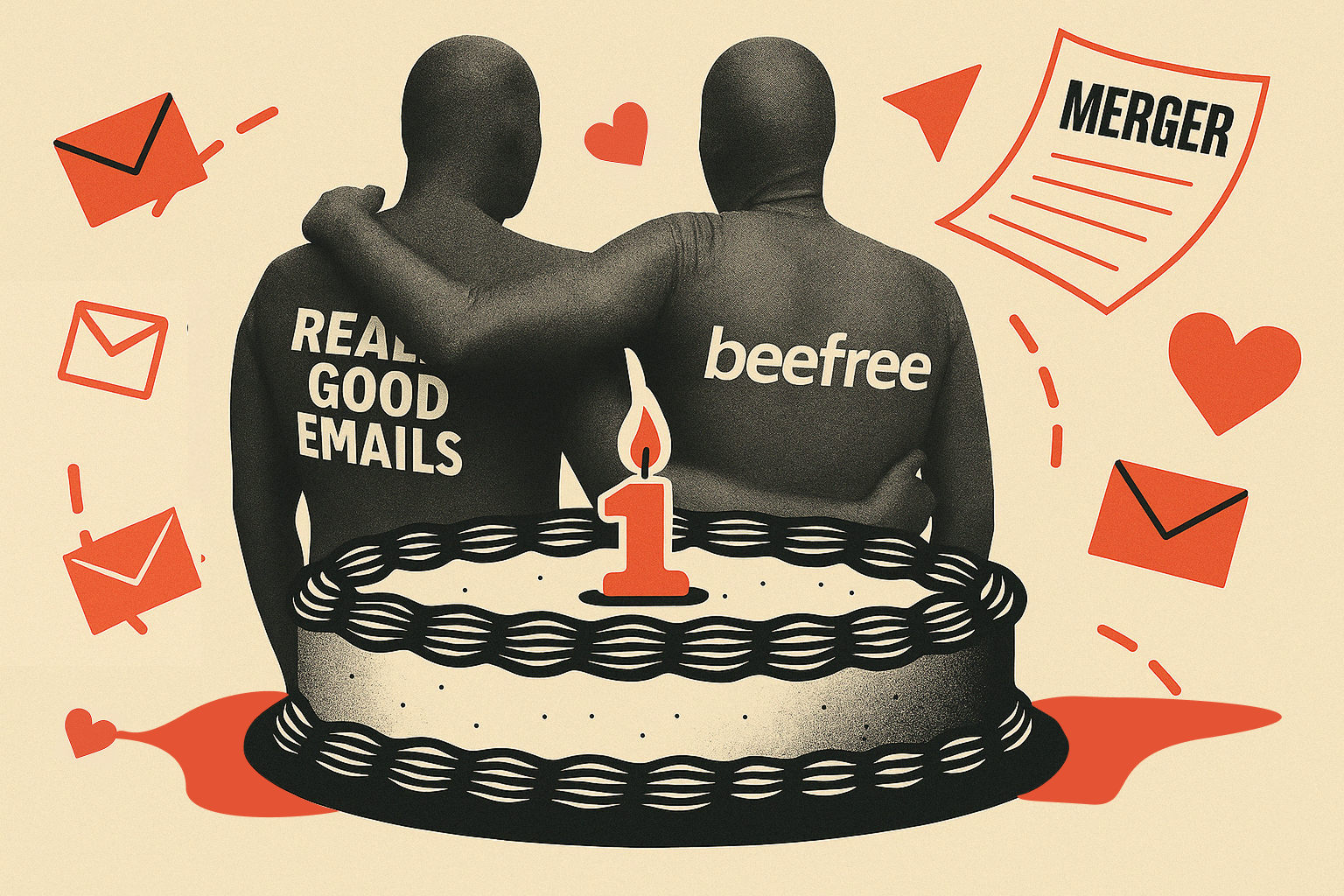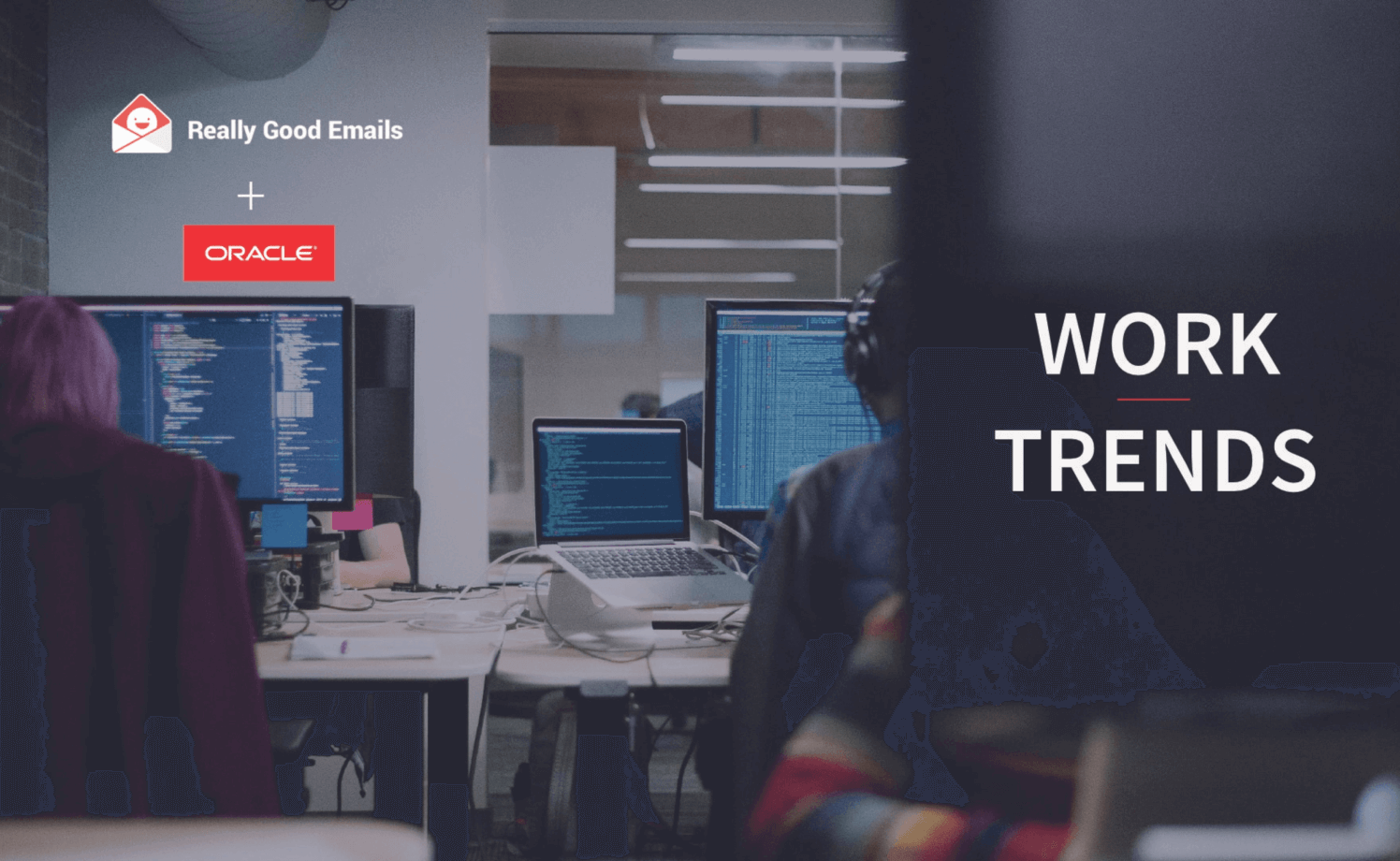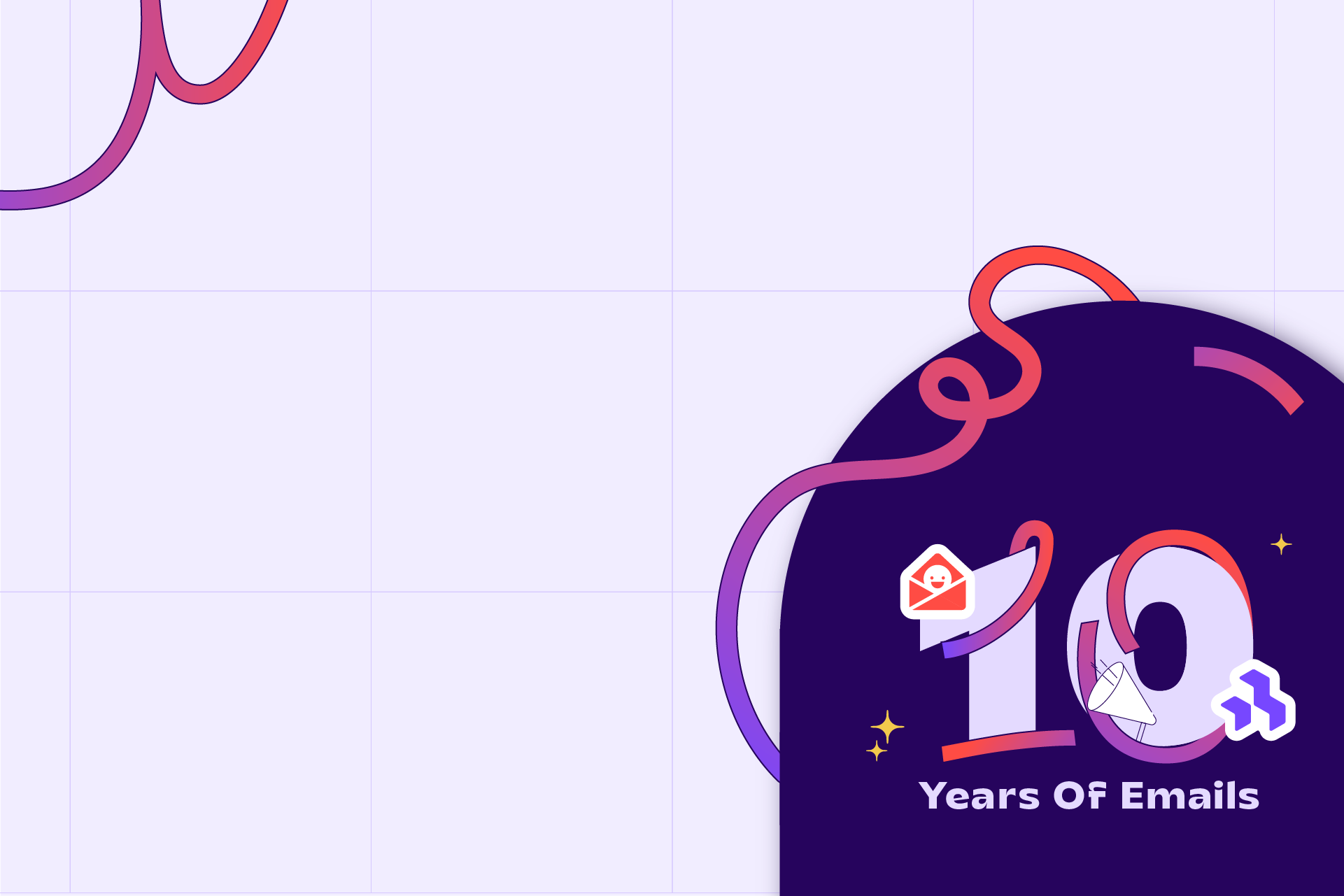So we're going to talk about some email marketing work trends. It's a combination of a survey that Really Good Emails did and then I supplemented it with some research of my own at Oracle. Just kinda mixing the two.
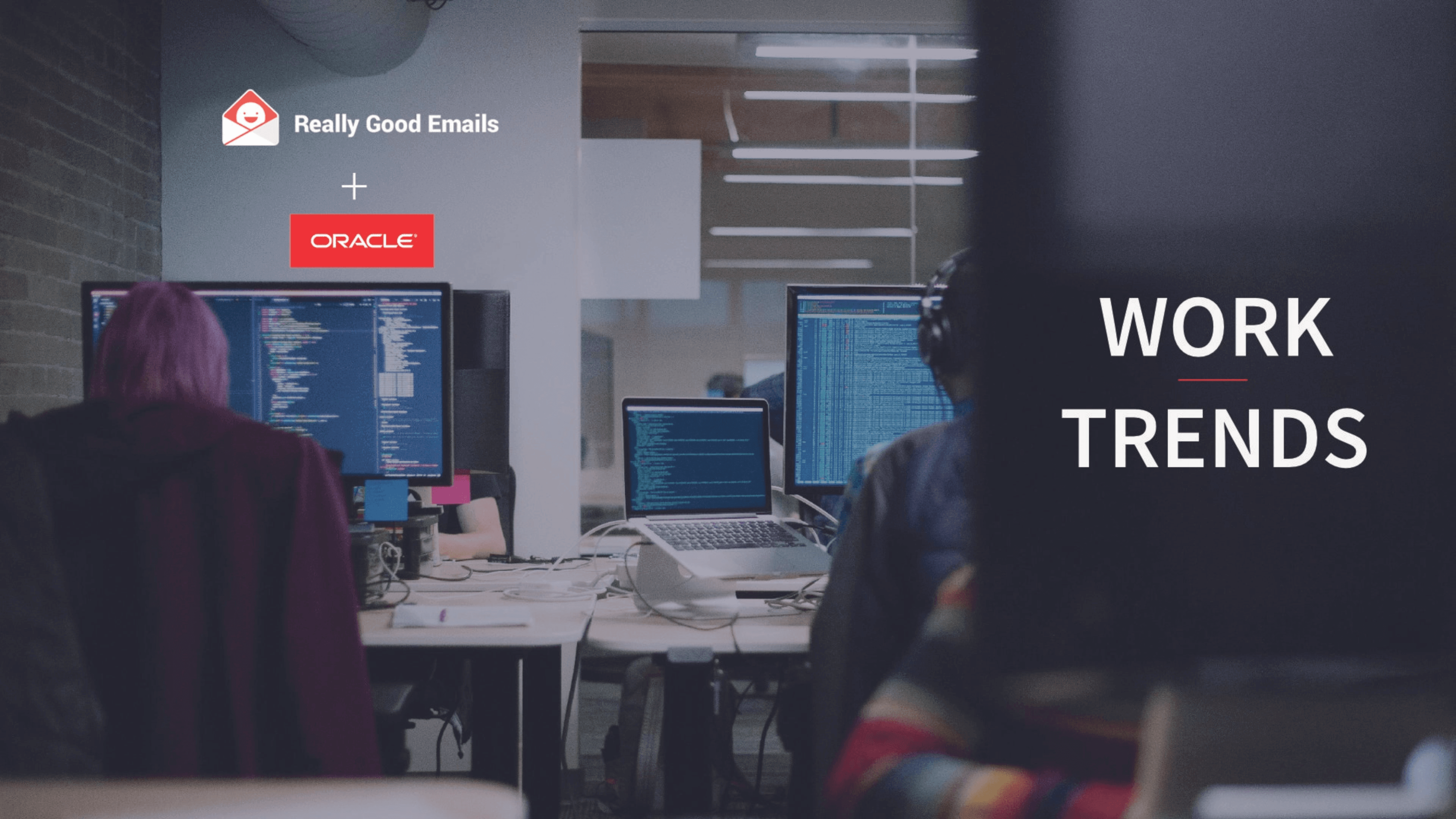
So for those of you don't know me, my name's Chad White. I'm the head of research at Oracle CX Marketing Consulting. We're a global full-service agency of about 500 folks who know everything about digital marketing.
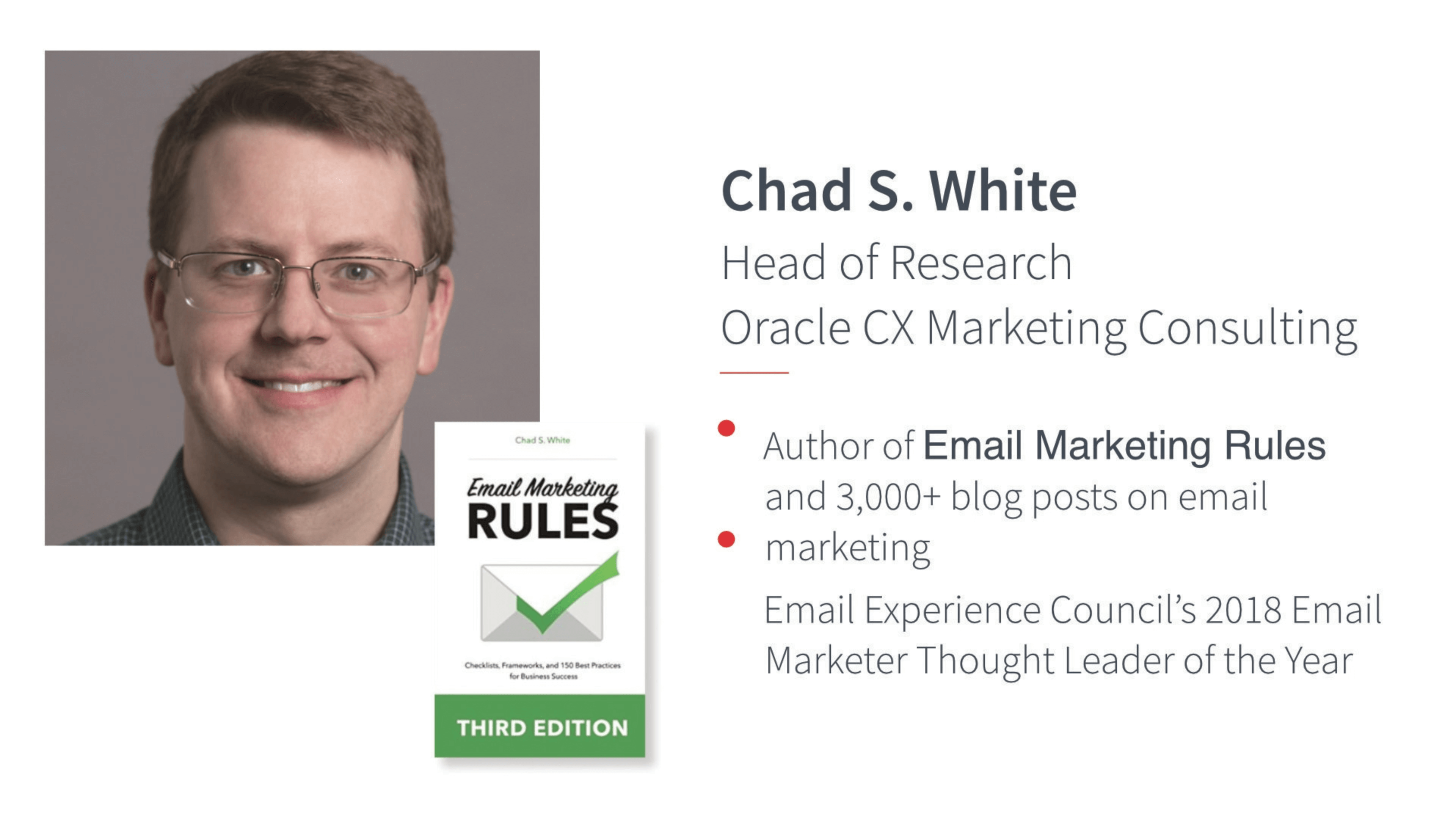
I'm also the author of Email Marketing Rules, which is now in its third edition. Hopefully, you've had a chance to pick that up. I've written more than 3,000 blog posts about email marketing over the years, which is probably too many. I'm the EEC's 2018 email marketer thought leader of the year, which was a huge honor anyway, enough of that.
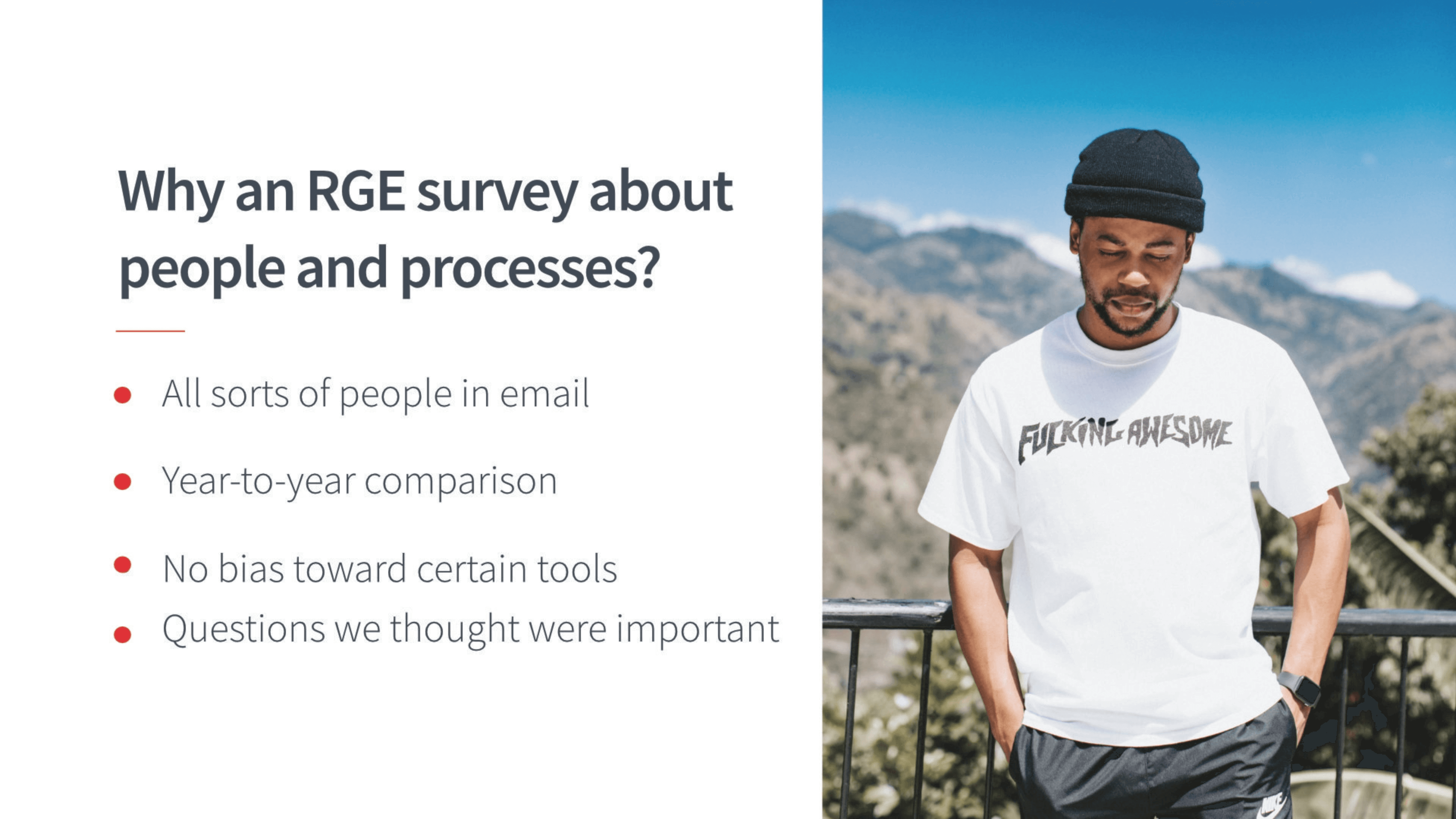
So I got a couple of surveys. Really Good Emails's survey is about people and processes and they recognized that there are all sorts of people that are in this industry and they wanted to capture that. They've done this survey for a few years now. So we have some nice, like year over year data that we can talk about. It's a neutral party, which is great. They don't have any agenda. So the survey data they collected, they could write the questions in such a way as to be sort of tech neutral.
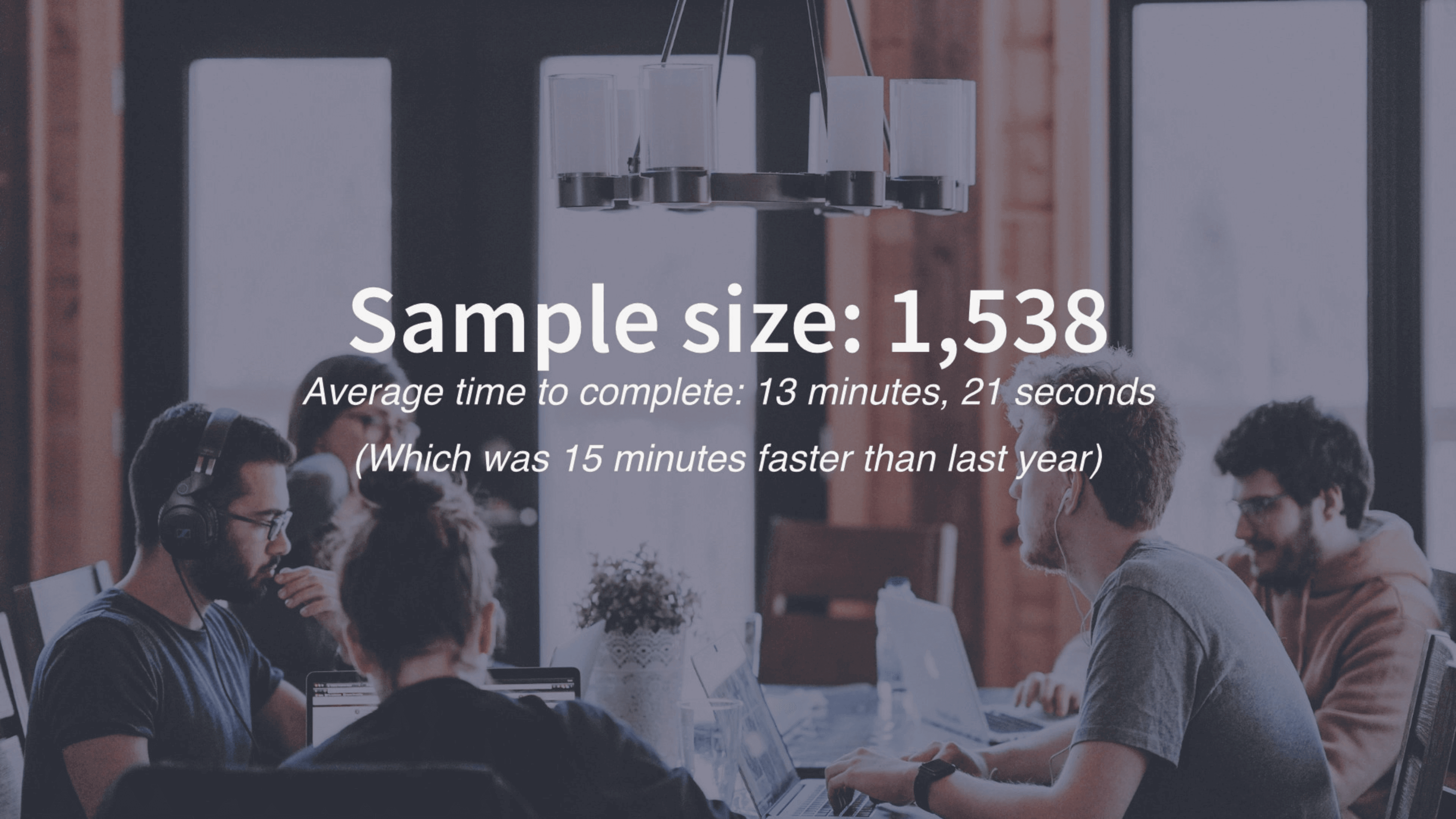
And then they wanted to ask some questions that they felt that other people weren't asking. So it's about 1500 people that took this survey. It took them about 13 minutes to take it. You guys got faster, you got like half the time to take it, which is great.
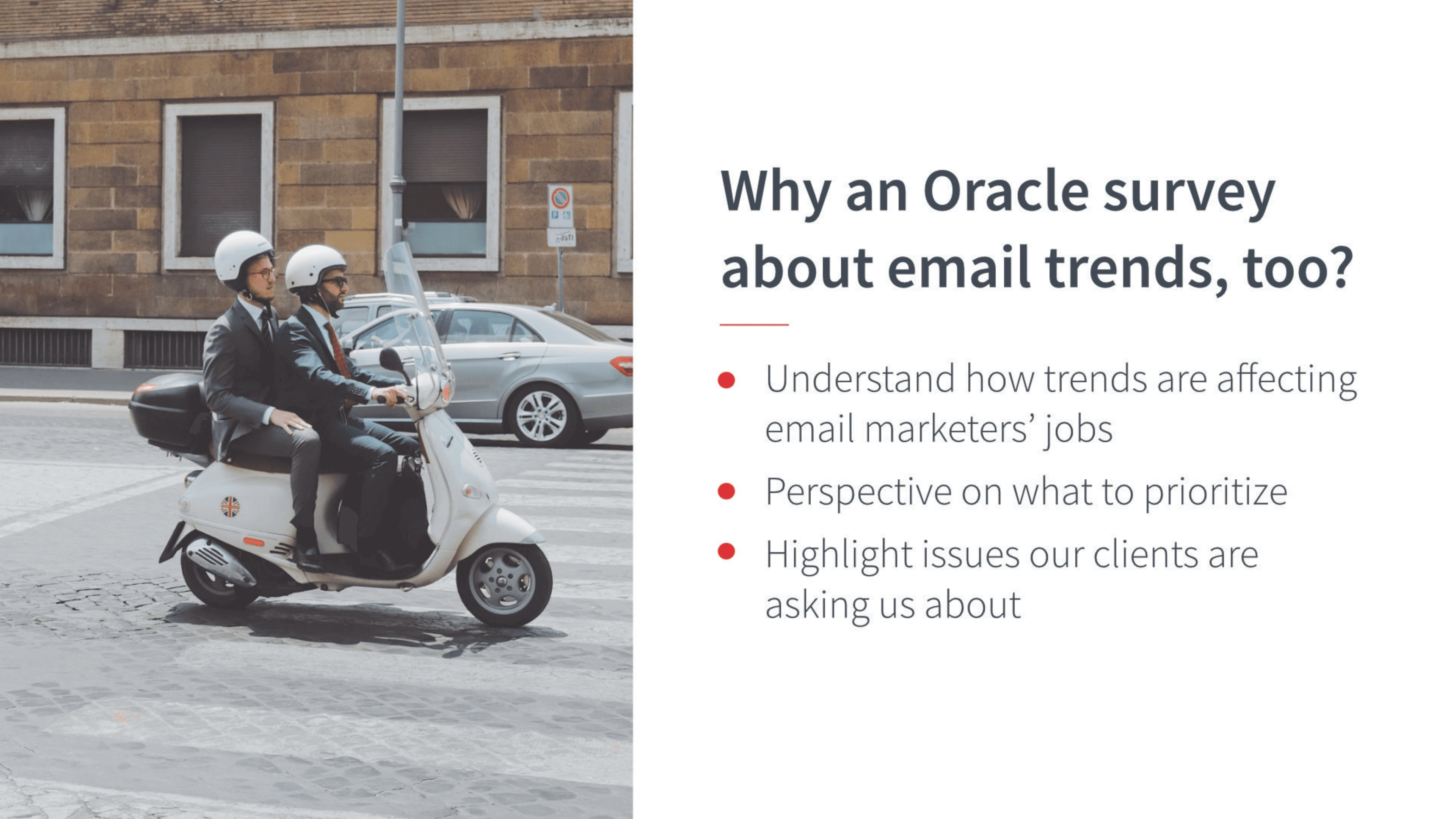
Then the Oracle survey we did was about email marketing trends. We want it to be able to understand how the trends were affecting, email marketers' jobs. We wanted to give you some perspective on what we feel like you should be prioritizing. There's a lot you can do and you can't do it all. We also wanted to highlight some of the issues that our clients were asking us about. We get some questions over and over again, and that helps give us focus.
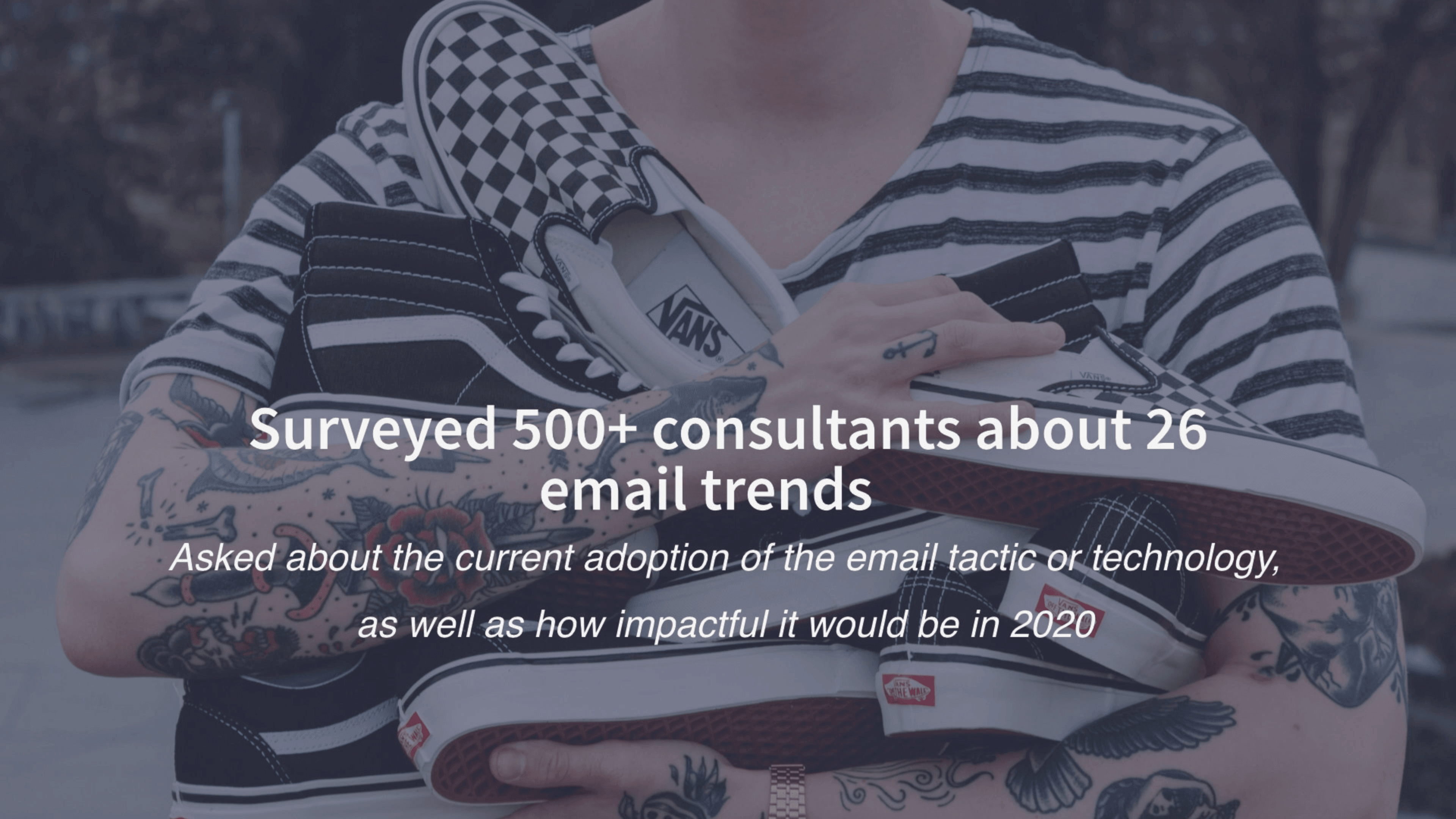
So our survey was internally of our more than 500 consultants. We asked them about 26 different email marketing trends. We asked them about what they thought the current adoption rate was in the industry and about how impactful that particular trend was going to be this year.
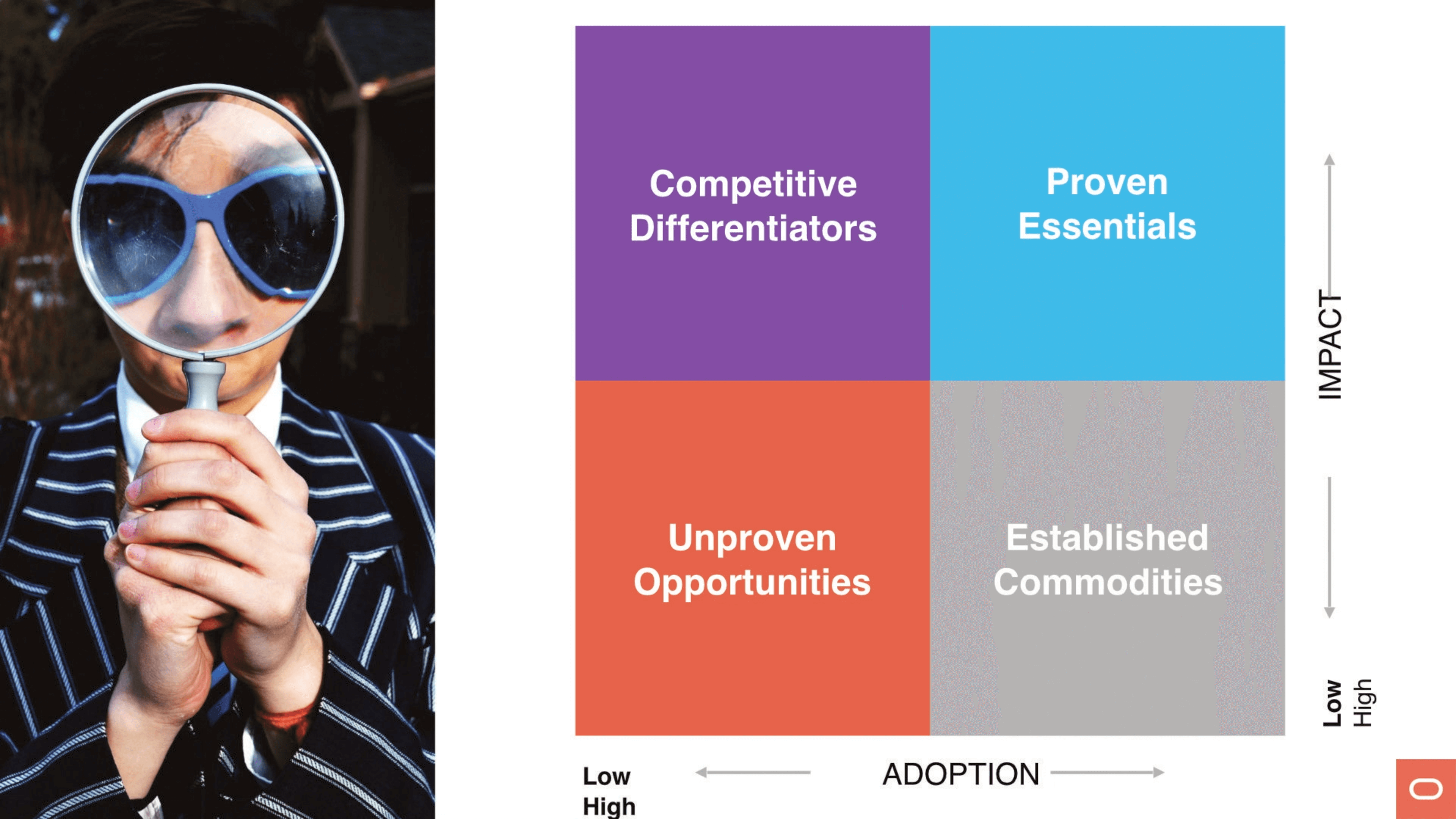
As all good research is you put it into quadrants. And so we mapped it according to that adoption rate, whether it was high or low, and then that impact whether it was high or low, and we've dropped them into these quadrants and are sort of a low adoption, low impact we have are unproven opportunities and are low adoption, high-impact. We have competitive differentiators and our high adoption, high impact. We have our proven essentials. And then our high adoption, low impact, we have our established commodities.
And so throughout the presentation. I'll be referring to this grid. You'll see where things kind of lie and it gives you an idea of, Hey, what are we talking about in terms of adoption? What are we talking about in terms of the impact of this trend? Is this something I should be paying attention to? Or is this something that can maybe put off?
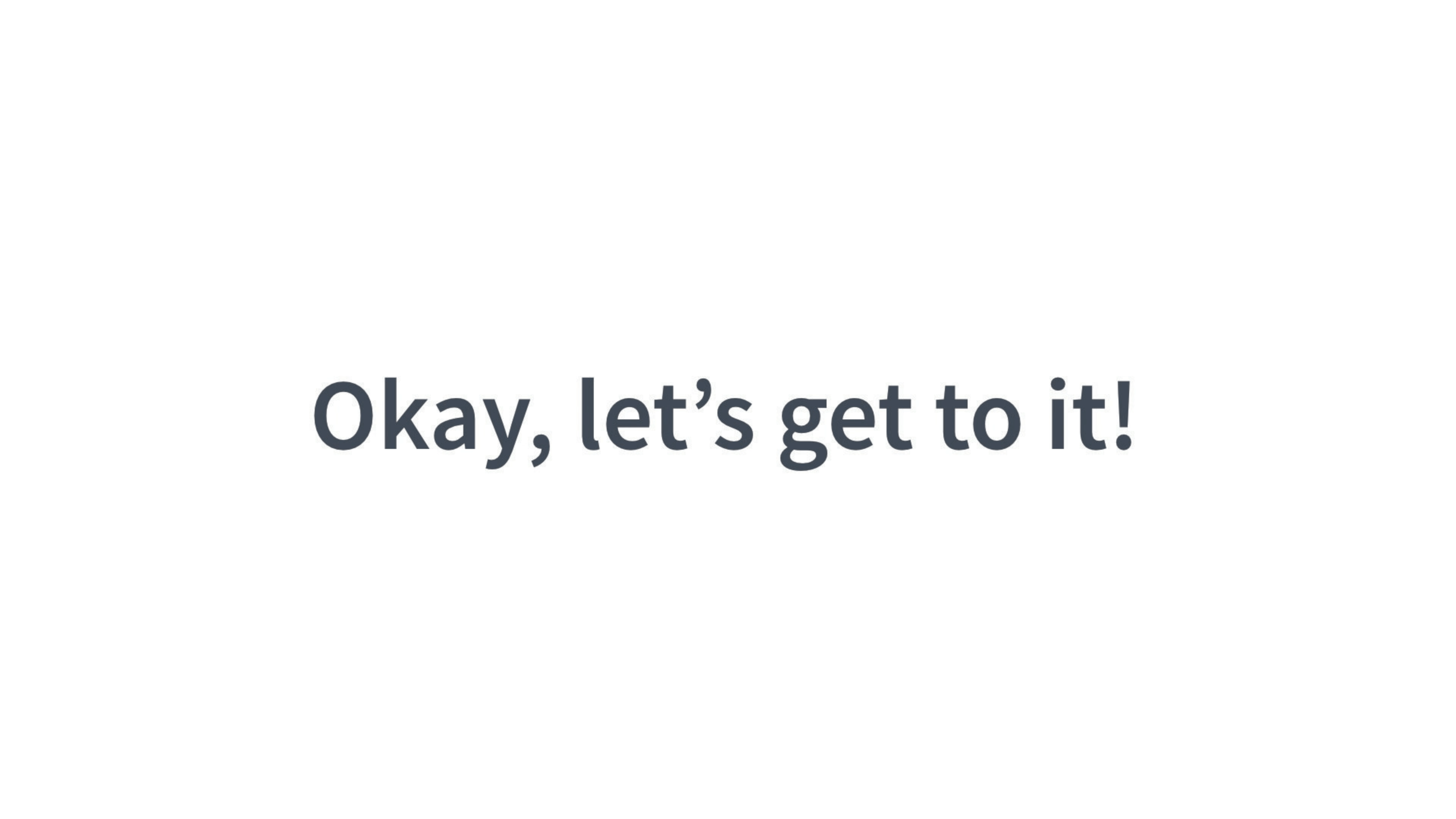
Alright. With all that said let's get to it.

Let's start with the people. All of you. The part-time, full-time breakdown in the industry right now is that we've got a little bit more, full-time folks year over year.It's about a 12% increase in the number of people that are full time.
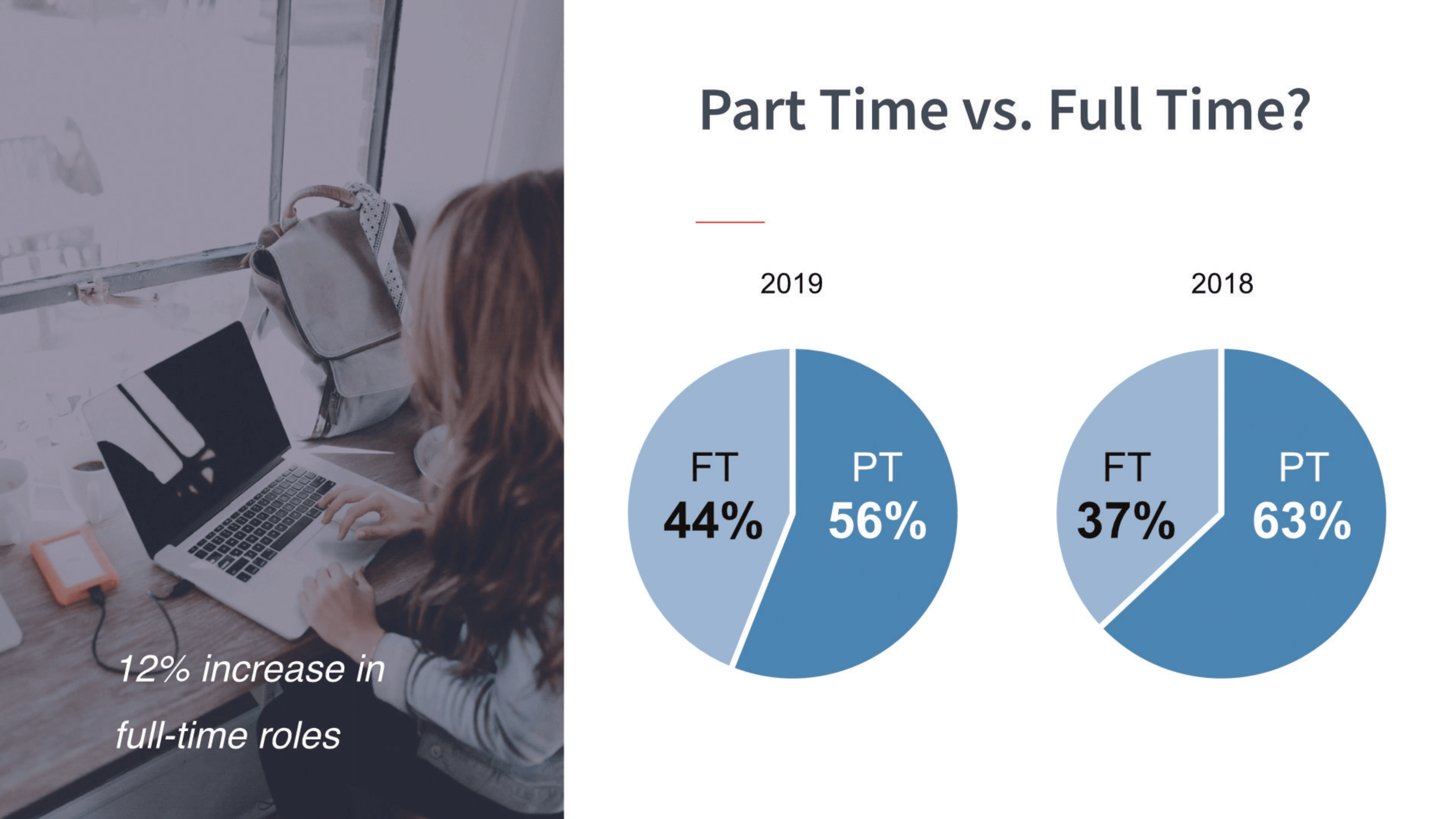
I see this as a good trend. It's a trend that indicates that the industry is maturing. It will be confirmed by what we see with team sizes coming up. but I think there's a very good trend, but there's still a lot of you that are doing emails, sort of part of your job doesn't necessarily mean that you are part-time workers.
It means that you probably are wearing multiple hats. So part of your time is spent on email. The other part of your time is spent over on the web or social or something else. But in general, there are some good trends here.
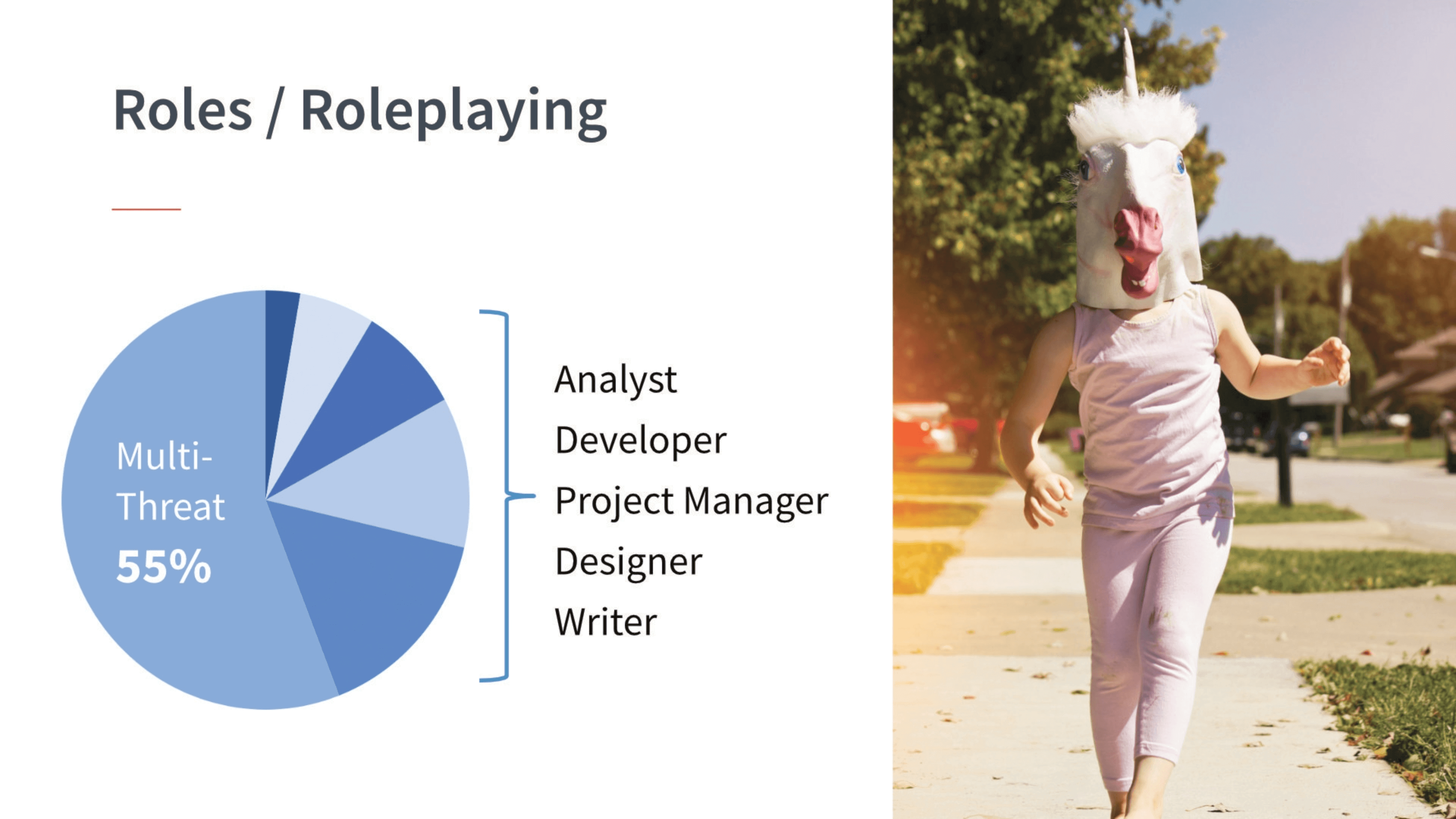
In terms of the roles that you're playing, about 55% of you are what I like to call multi-threat, you're kind of doing it all. You're wearing all the hats. You've got all the tattoos. So that's a good thing. And again, this aligns with some of the other data that we see later on. And then the rest of you are part of this 45% that are specialists. You're specializing and being an analyst, developer, project manager, designer, and a writer.
This is something that we're going to see, I think, much more of going forward. So if you are one of these multi-threat people you should probably start thinking about, all right among all the things I'm good at how could I potentially specialize.
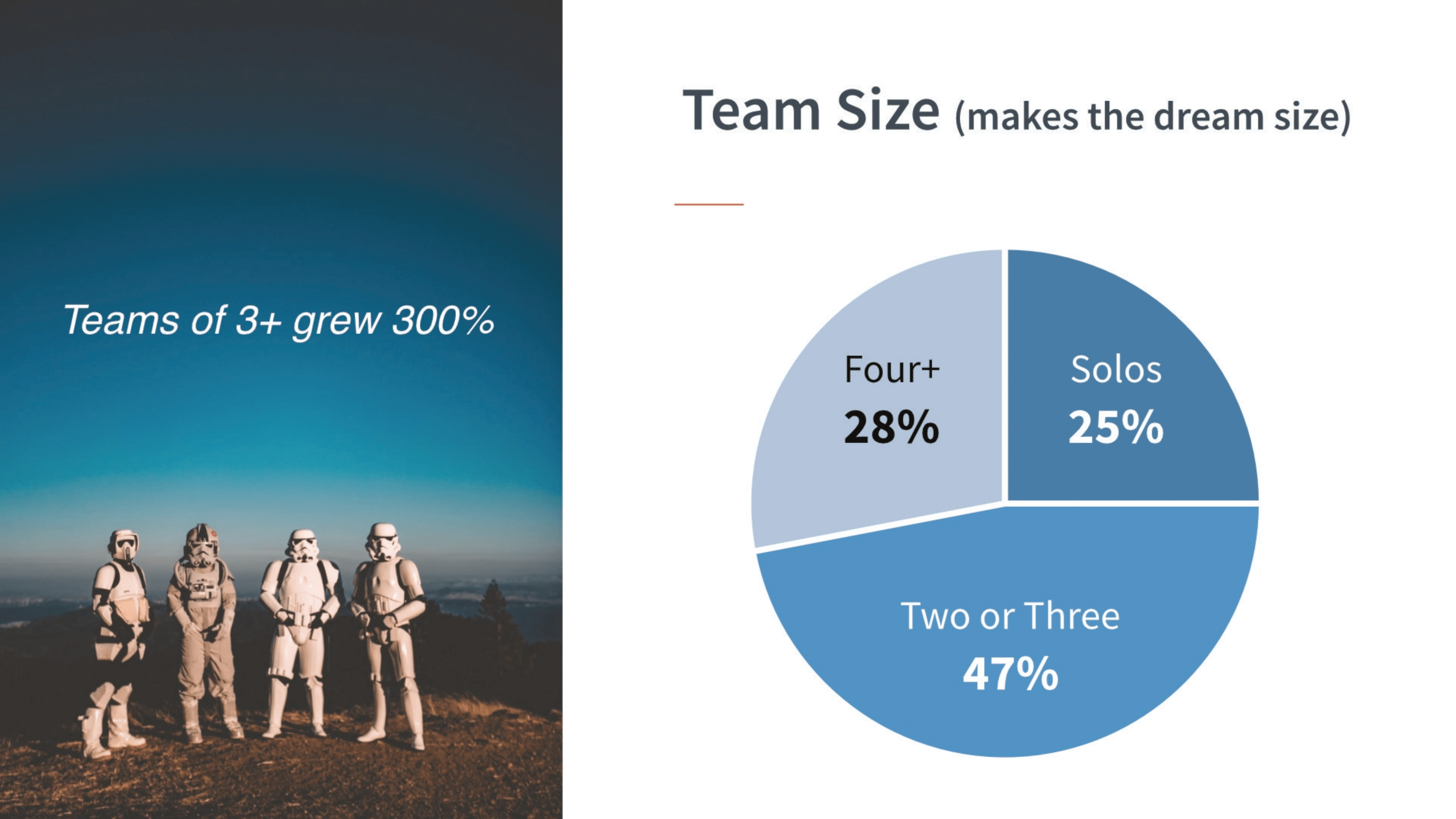
Team size. We see about 25% of you are solos, wink, wink, Star Wars reference. Nearly half of you are in teams of two or three. Then there are the big boys four plus-sized teams. That's roughly about a quarter of you. We're seeing pretty good growth in team size, which I think is good because it allows more specialization. Cause you can only do so much when you're dividing your time between lots of different disciplines.
So definitely a good, strong growth here in team size, which I think demonstrates that brands want to go deeper and they get more knowledge about particular facets of the job.
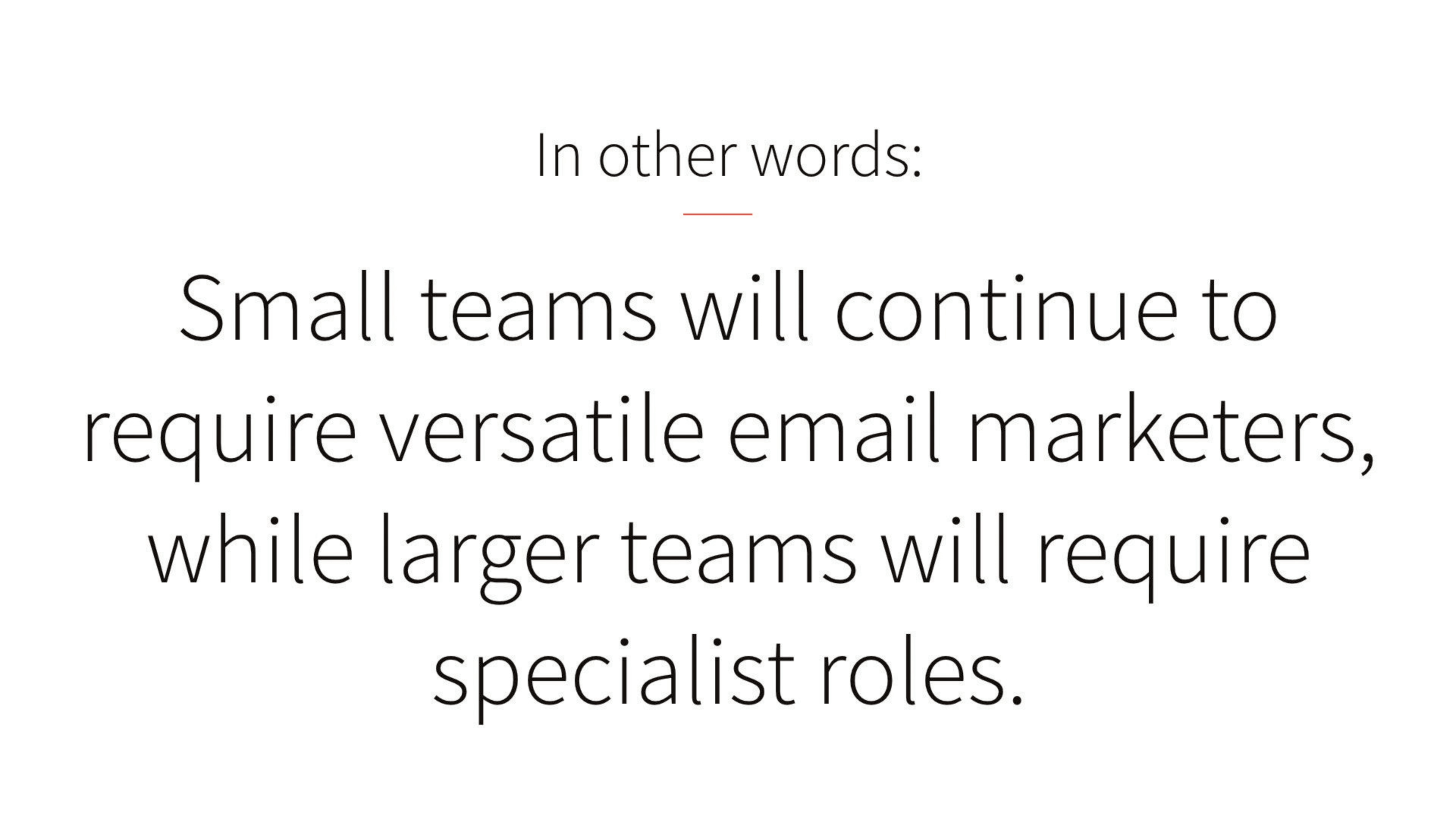
So in other words, we're going to see small teams continue to require versatile email marketers that know how to do lots of things decently well, but these larger teams are going to require more specialist roles. That's something you should be thinking about when you're kind of mapping out your career arc in the industry.
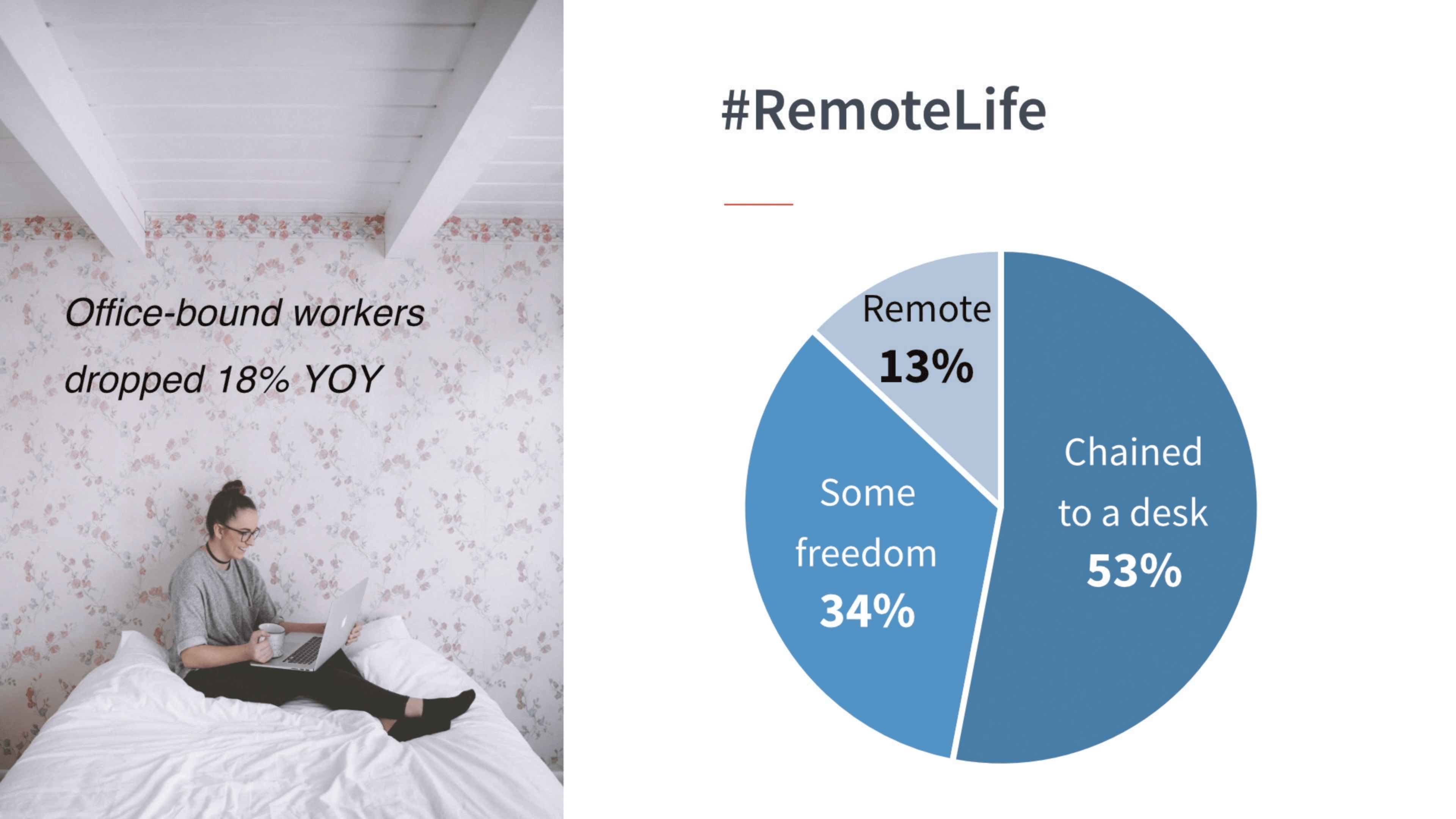
Let's talk about remote life. About 53% of you work in offices full time. A little bit over a third of you have some freedom. That probably means you can work from home a day a week, two days a week, maybe three days a week. Just great.
Then 13% of you are like myself are fully remote. I've been fully remote for about 14 years, which is amazing and awesome for myself and my family. I hope that more of you get the opportunity to do that. I have a bold prediction that by the end of the year, a lot more of you will be remote or have at least some freedom to work remotely.
We are about to embark on a grand experiment in remote working. I think that a lot of companies will find that the world doesn't stop and that productivity maybe even goes up and that everyone is a bit happier. And they can take care of their families better. Huzzah. So I have a feeling that we're going to see a lot more flexibility in the future if that's something that you like.
I love working remotely, but it's not for everybody. I know people who are people, people, and they love being around other people and it gives them strength and energy and propels them through their day. So remote life is not for you, but for those of you who like some flexibility, it can be wonderful. I think more of you will be getting that whether you want it or not. This is on top of a drop of 18% year over year of people being office-bound.
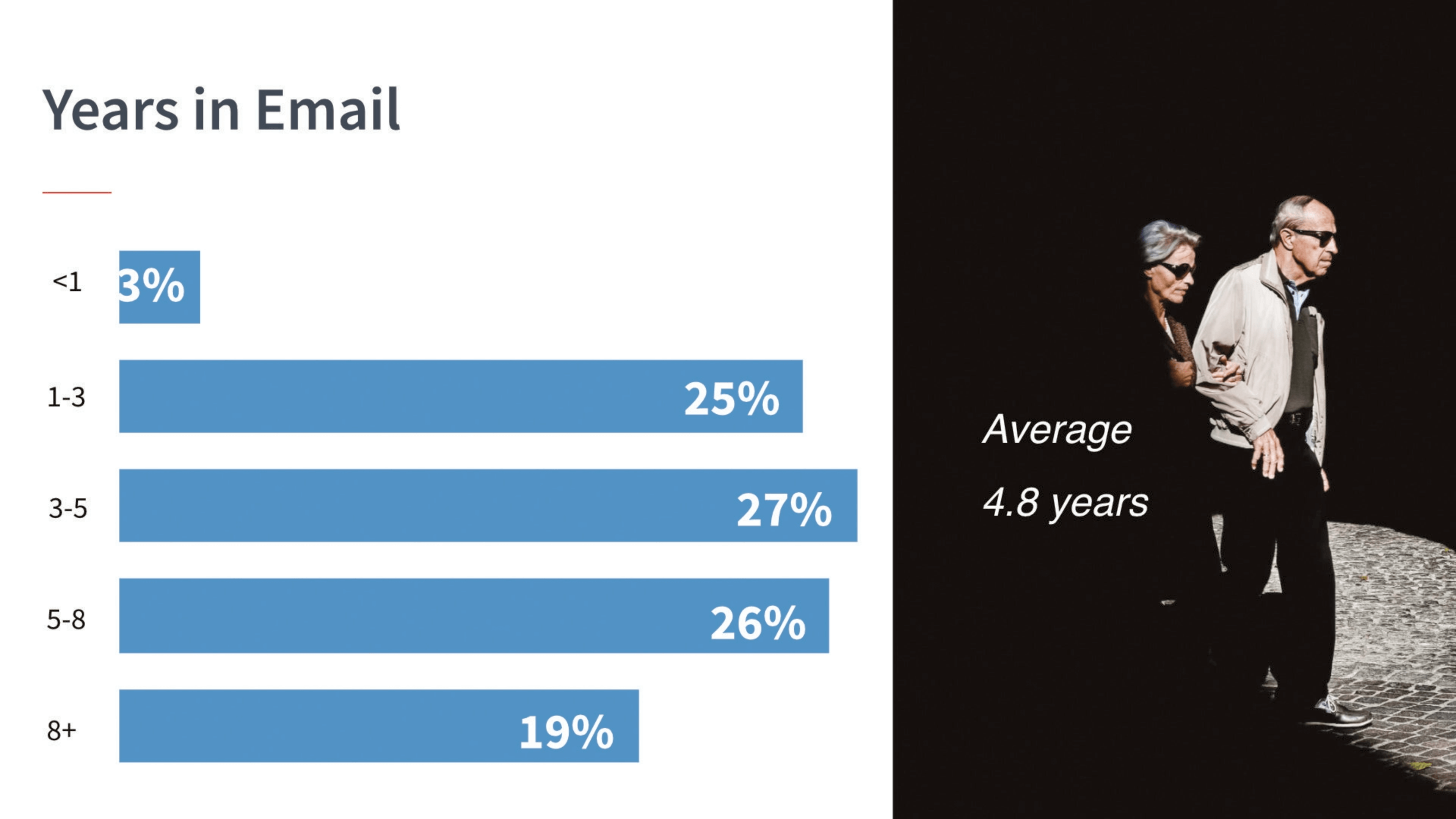
In terms of the tenure in the industry, among the survey respondents, it roughly breaks down into quartiles. Very few people were very fresh in the industry. About a quarter had been in for a year to three years, about a quarter three to five years, and a quarter, five to eight years. Then there were roughly 20% that had been for eight or more years. On average about 4.8 years. So if you've been in the industry five years, you are a certified veteran. You've seen a lot.
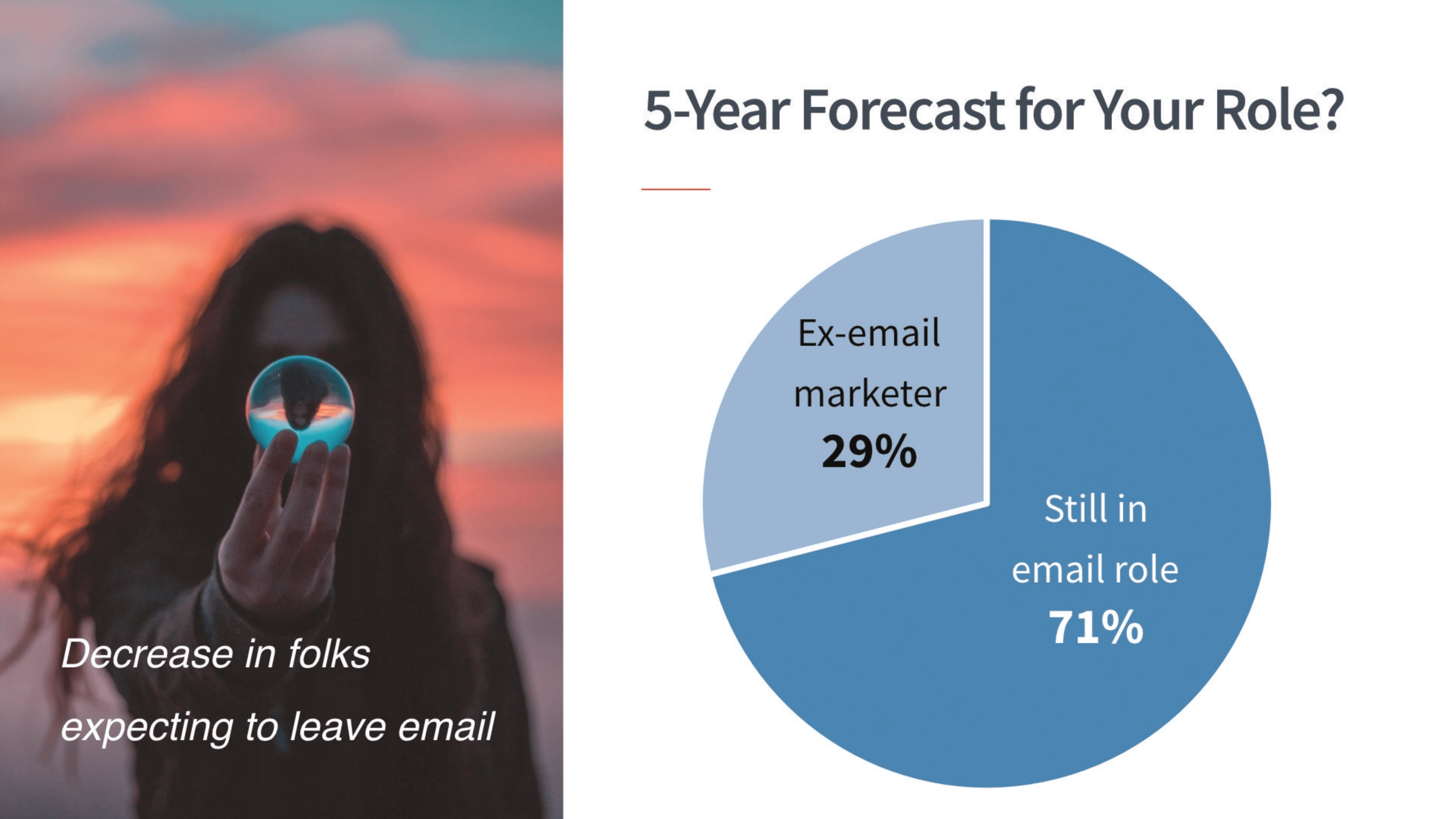
So looking ahead, Really Good Emails wanted to know how you were feeling about being in the industry. Did you think you were still going to be in the industry? About 71% said that they still expected to be in an email role in five years and about a little bit less than a third thought that they'd be moving on to something else. To me, this feels it's pretty amazing because email is a stepping stone to other parts of the business, into other parts of marketing.
If you're in email, You're learning about segmentation. You're learning about CRM. You're learning about personalization. You're learning a lot of great data skills, and I hope that a lot of you, especially the designers who are here are leaning into that. That is super valuable skills that you can learn about how to use data to target and to message. And if you have those skills, you can be able to, I don't wanna say promoted out of email, that you can rise above and be able to oversee lots of aspects of marketing, including email, but also social and web and other things.
So really super valuable skills. And we're seeing that there was a decrease in the folks who were expected to leave email. So definitely email can be your forever thing, or your longterm thing. That's great to see. We're past the days of people being anxious about whether or not email was still going to be around. All the ridiculous email is dead talk being driven by a lot of this social media, people who have since gone out of business in some cases.
I hope everyone's feeling secure about email as a field. I don't see any reason to doubt that email isn't going away anytime soon. That's a whole long conversation, but I can tell you should feel pretty good about where you're at.
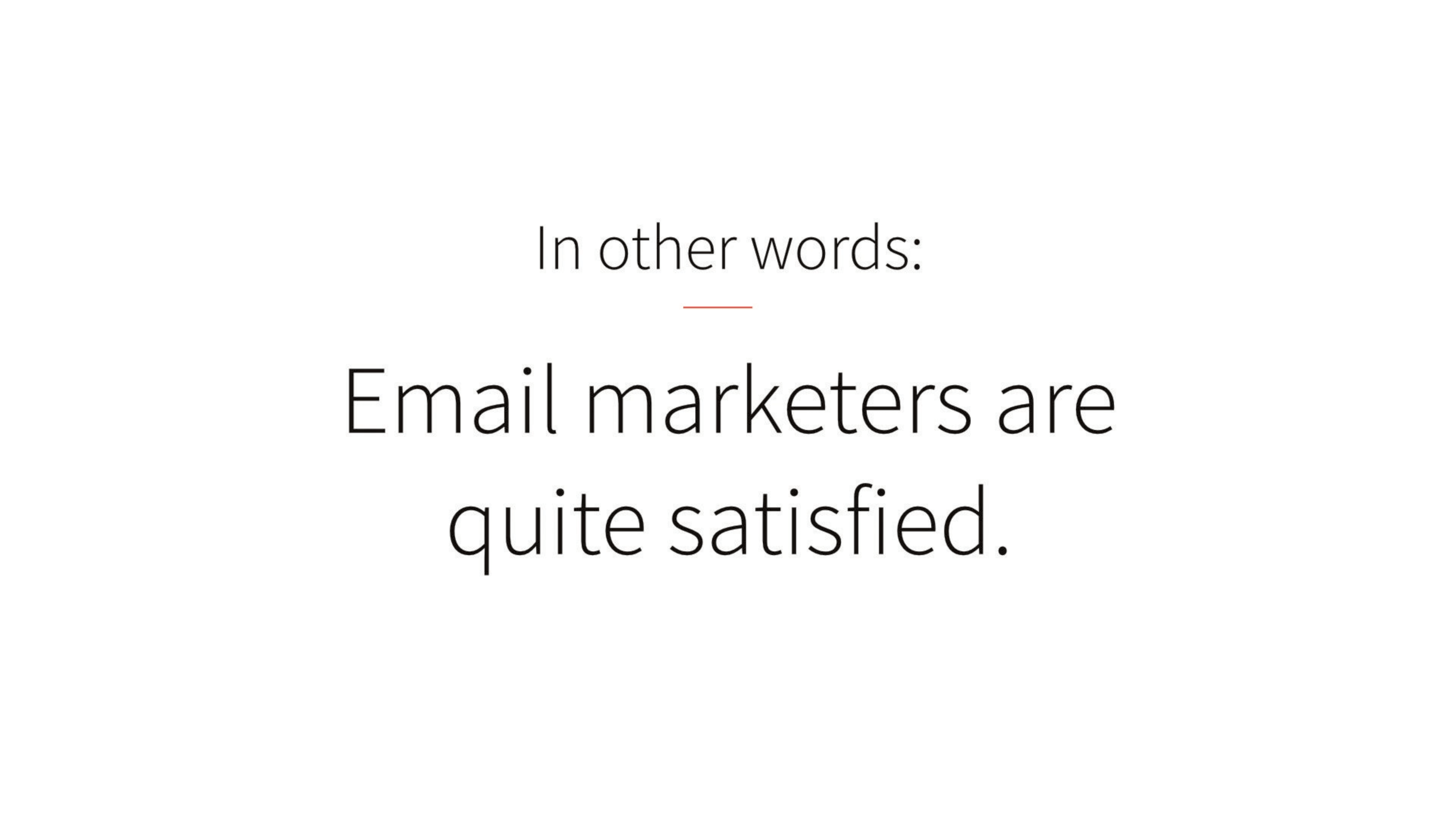
Email marketers are quite satisfied. This is fantastic to see, but there are some pain points in the industry.

I want to talk about those.
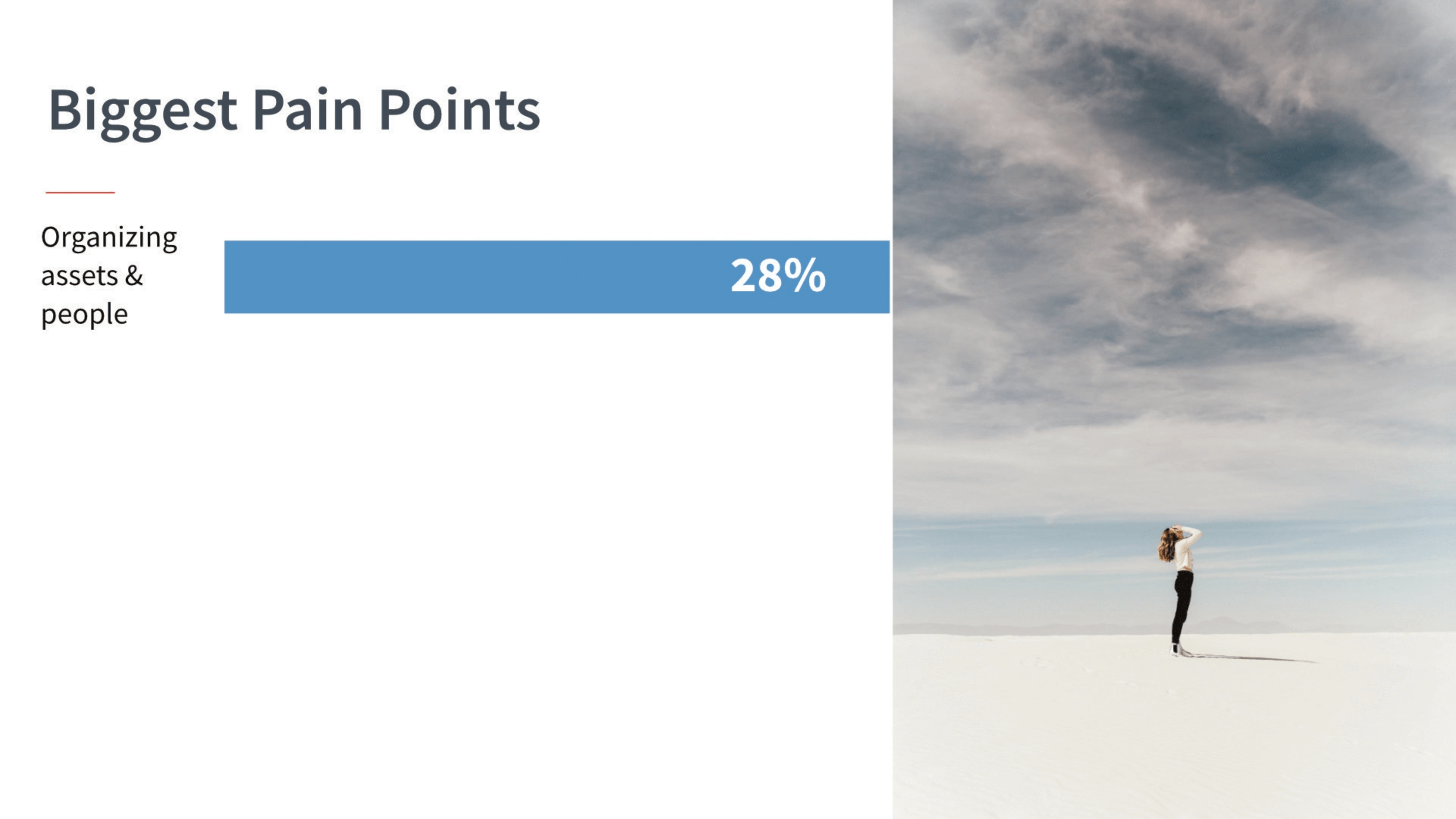
So among the pain points that Really Good Emails asked about the number one was organizing assets and people. Here's when we're going to start folding in some of the research that we did.
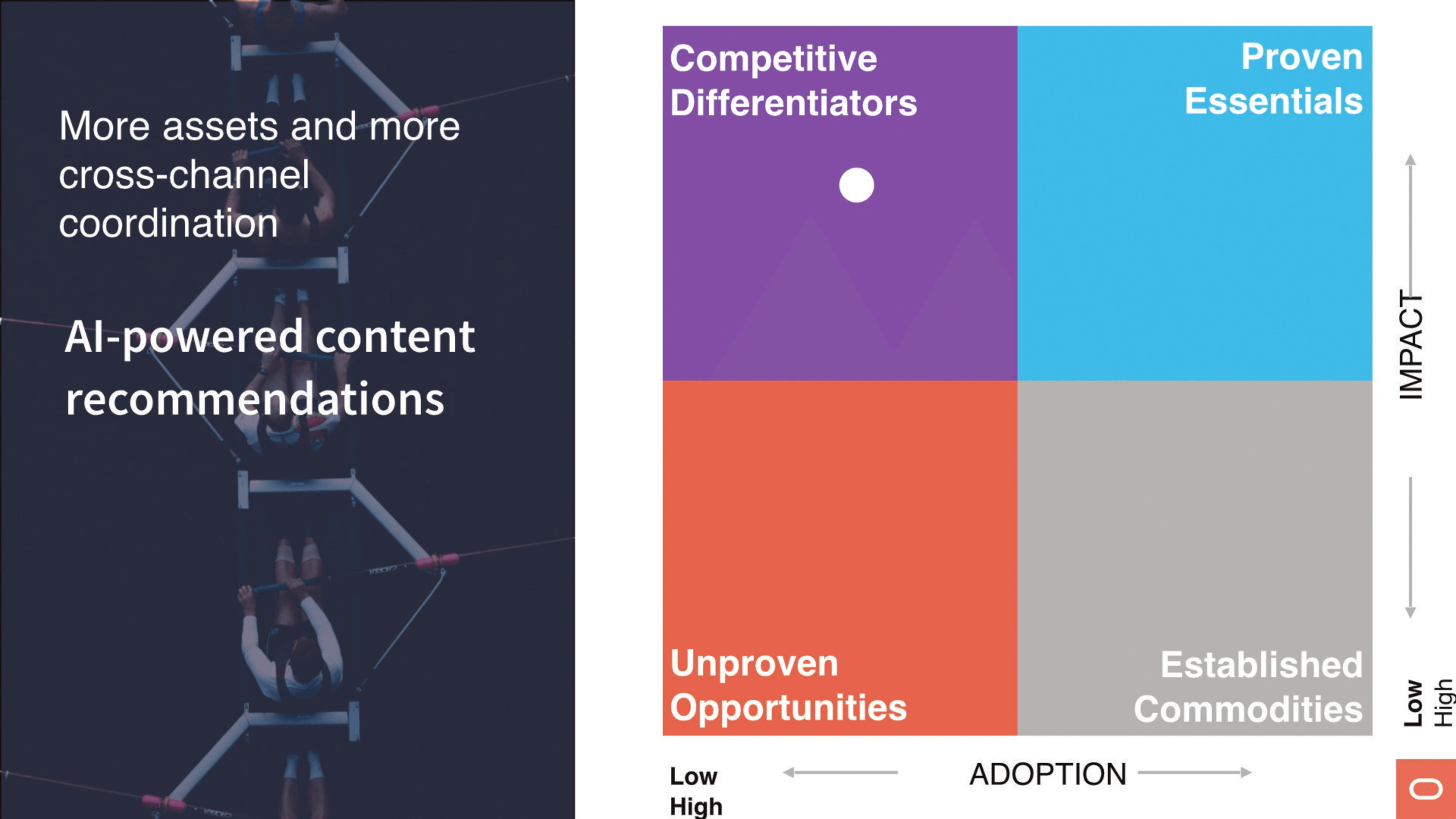
So there's more assets and more cross-channel coordination that you have to do. It's just sort of a fact of life. A few things are driving this, so for instance, high powered content recommendations. That requires a lot of asset creation, a lot of asset tracking, making sure that all of that is working the way that you want it to work.
This is one of our low option, but high impact trends. If you are a retailer, a media company, or a large B2B company, you probably have lots of SKUs, lots of assets, lots of content, that you are trying to get in front of the just-right people. AI is the absolute best way to do that, but it means that you're shuffling a lot of assets.
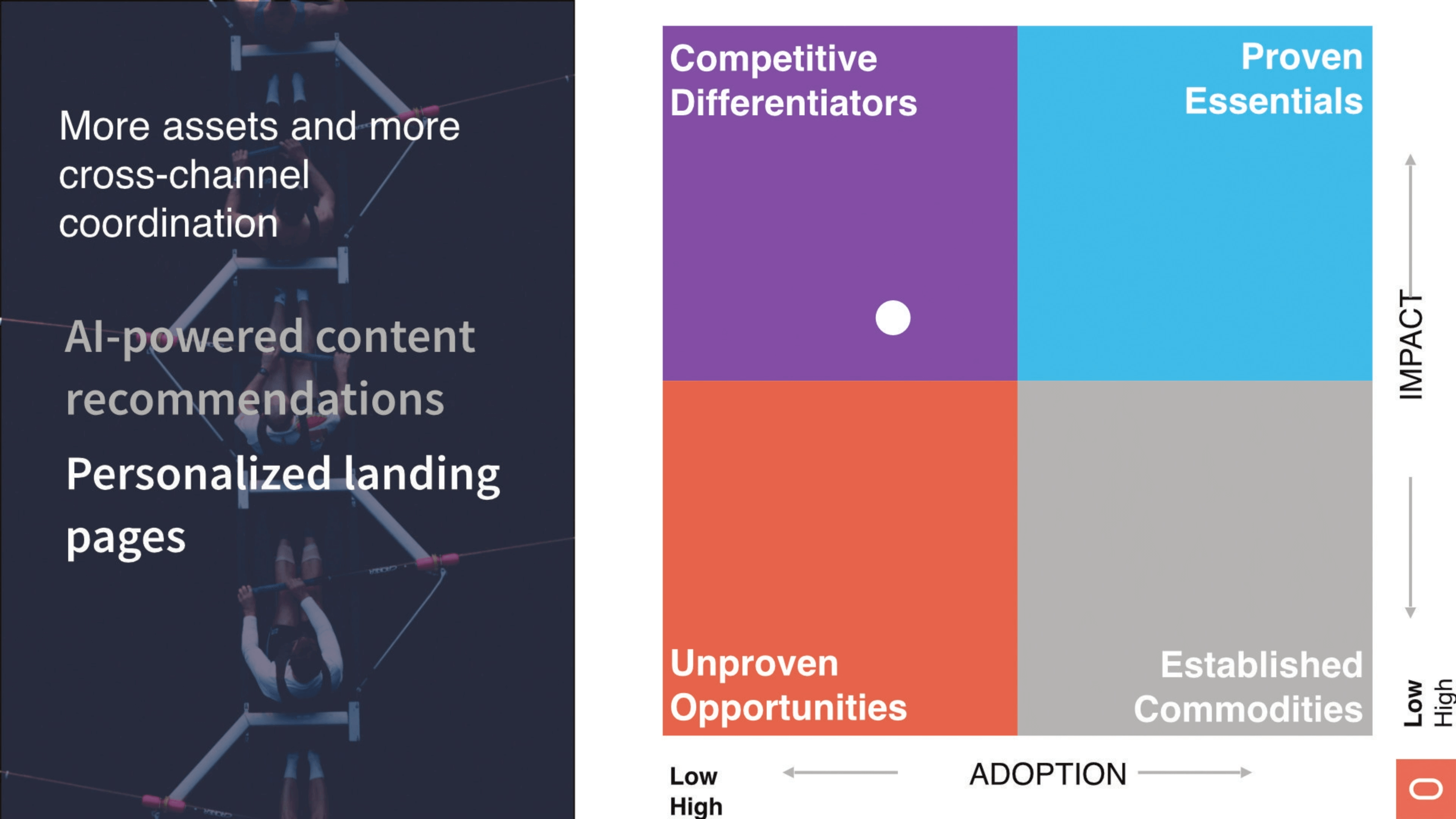
Personalized landing pages, probably roughly half of your email marketing departments have responsibilities for landing pages. Having a seamless transition from email or social or wherever to a landing page is something that's becoming more and more essential.
Having those personalized, where you're tracking that journey, and being able to populate that landing page with messages that can continue that journey in a nice seamless way is becoming essential. That means more coordination of assets and more team coordination. You're probably working with your web team who maybe doesn't care a lot about email and that can be a struggle.
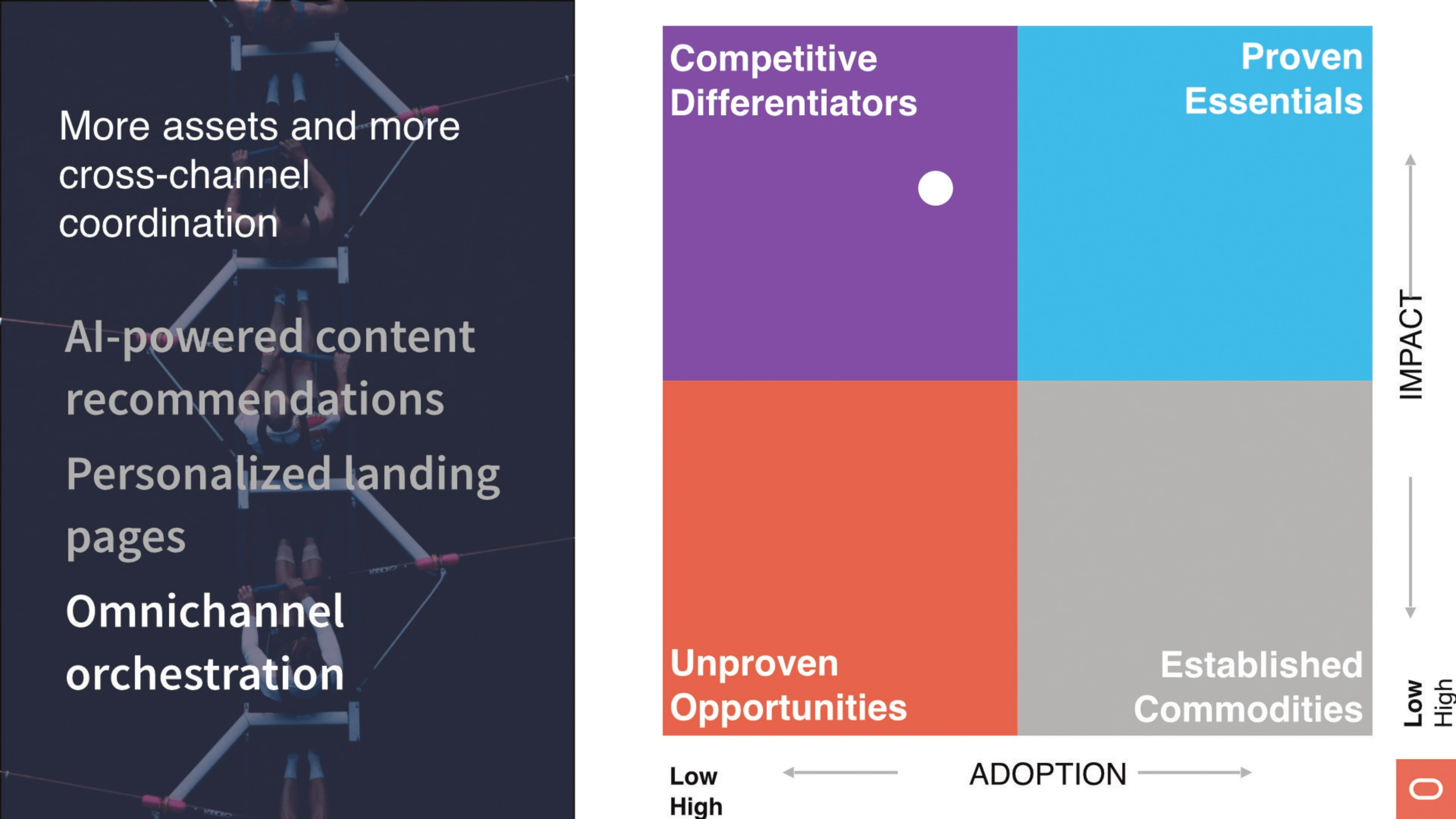
The big one is omni-channel orchestration. So landing pages is a small part of the equation, but if you're doing email right, you're probably having conversations with your social media team and your web team and print marketing. All of these things should be working together and as seamless as you possibly can.
This is a challenging trend, not only because consumers are super demanding and have high expectations of us, but because it means that we have to do so much coordinating with other people within our organizations. I think in the world of email, we know that the tech is hard. The coding is hard. Dealing with all the inbox providers is hard, but dealing with lots of other people who have different ideas than we do, that can be challenging. This is the thing we have to get much better at.
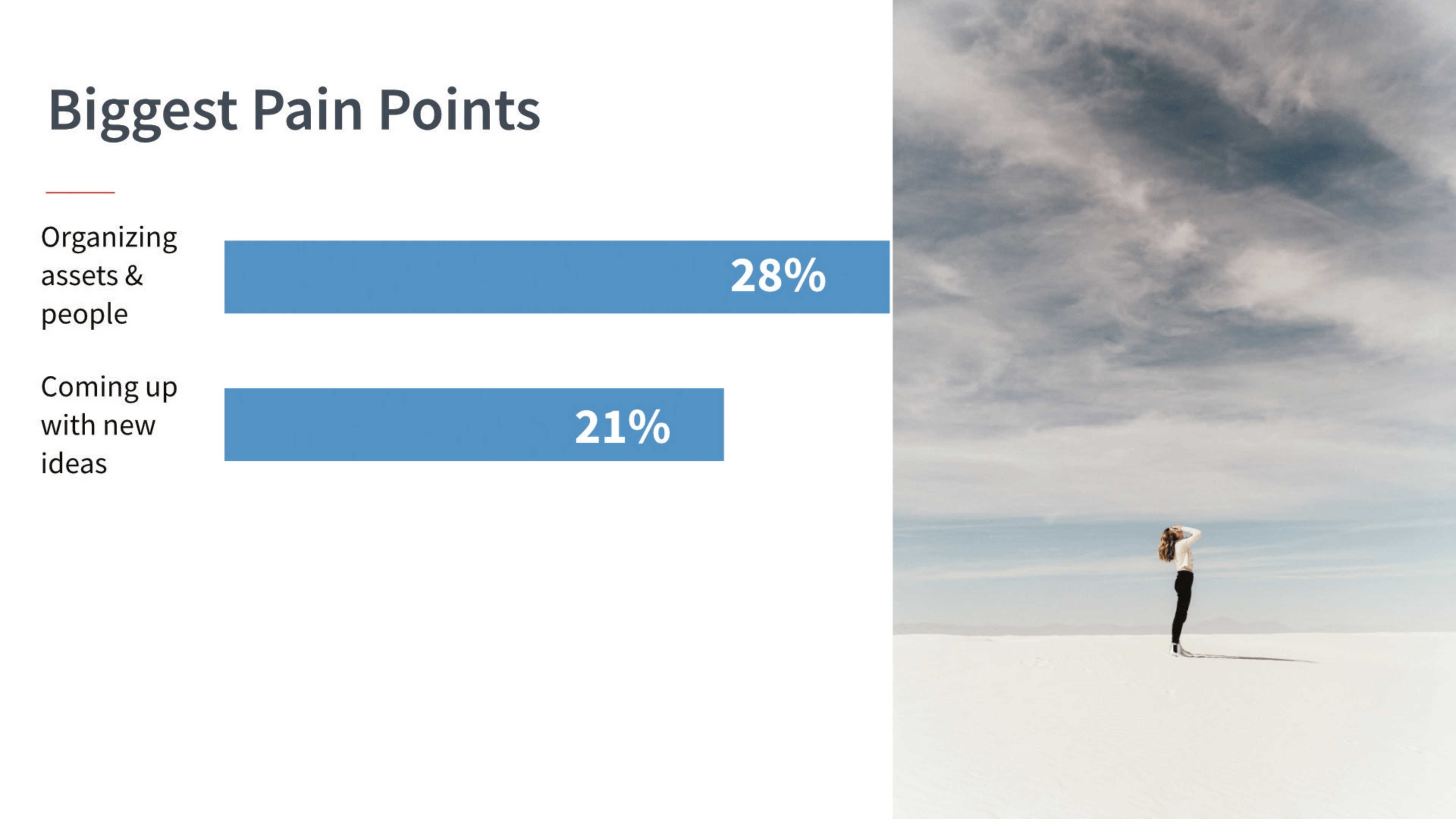
The number two big pain point is coming up with new ideas and here's where I'm letting the secret sauce out. So make sure you take note of this. This is the way to get new ideas. It's this right here.
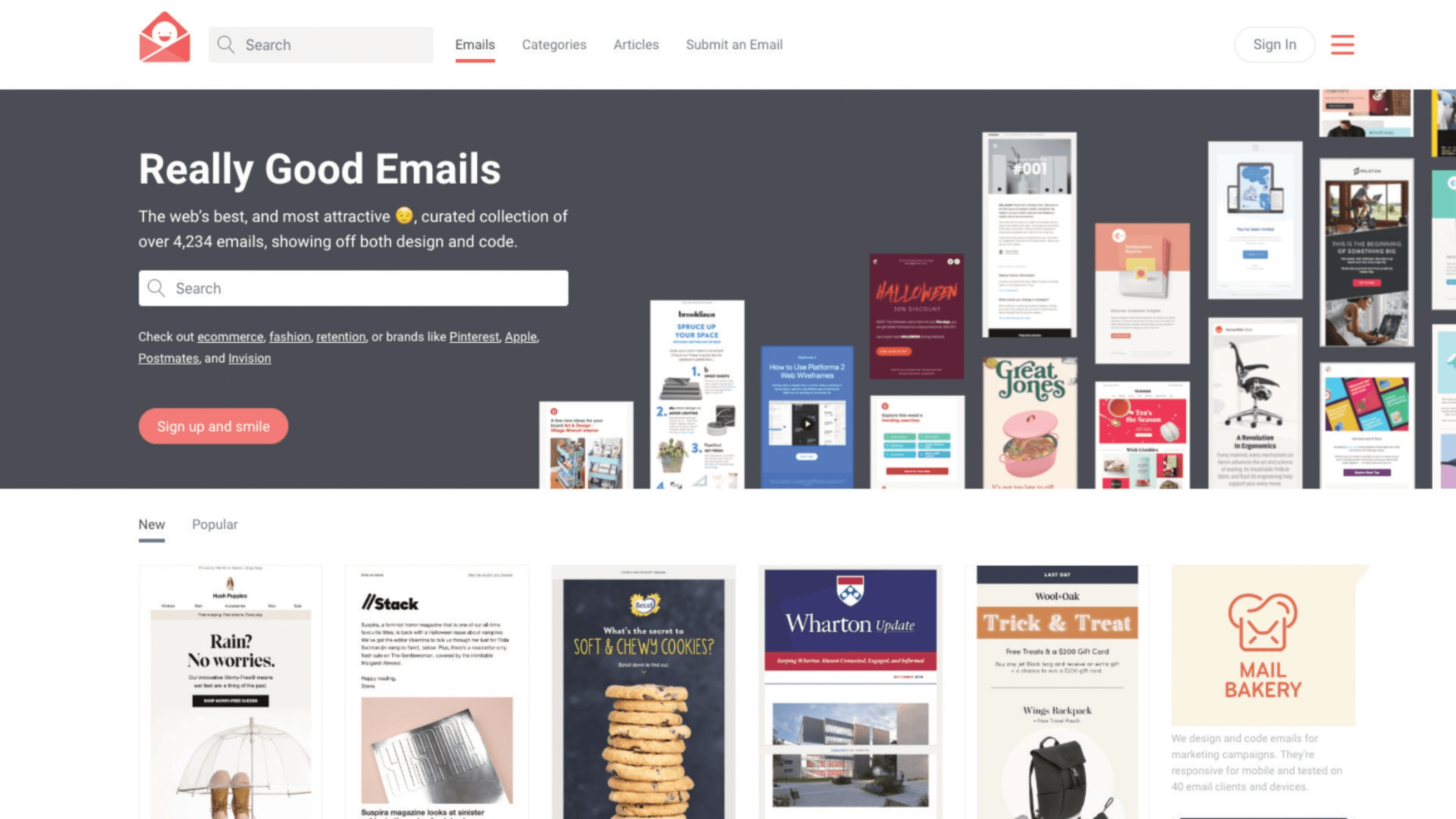
Really Good Emails. A great way to get new ideas. Matthew was saying like don't steal, but I think what you absolutely should do is steal. It's the borrowing you don't want to do. You want to make it your own. You want to steal it hard so that they can't even tell where it came from. Look at what other people are doing and then take those ideas. Take that little bit of code, a little bit of code here. Take those visual design ideas, take some messaging, steal some CTA language, but just take a little bit here a little bit there and it's all good.
There's no reason to have to come up with new ideas out of nothing. There's inspiration all around us. This is a great place to get it. You should also be having your own personal swipe files, where you're saving emails that you get that you think are awesome. Save those. Put them in a place that your whole team can get to them. Maybe start every one of your weekly meetings by sharing a few of those emails and talking them through so everybody's on top of what's going on.
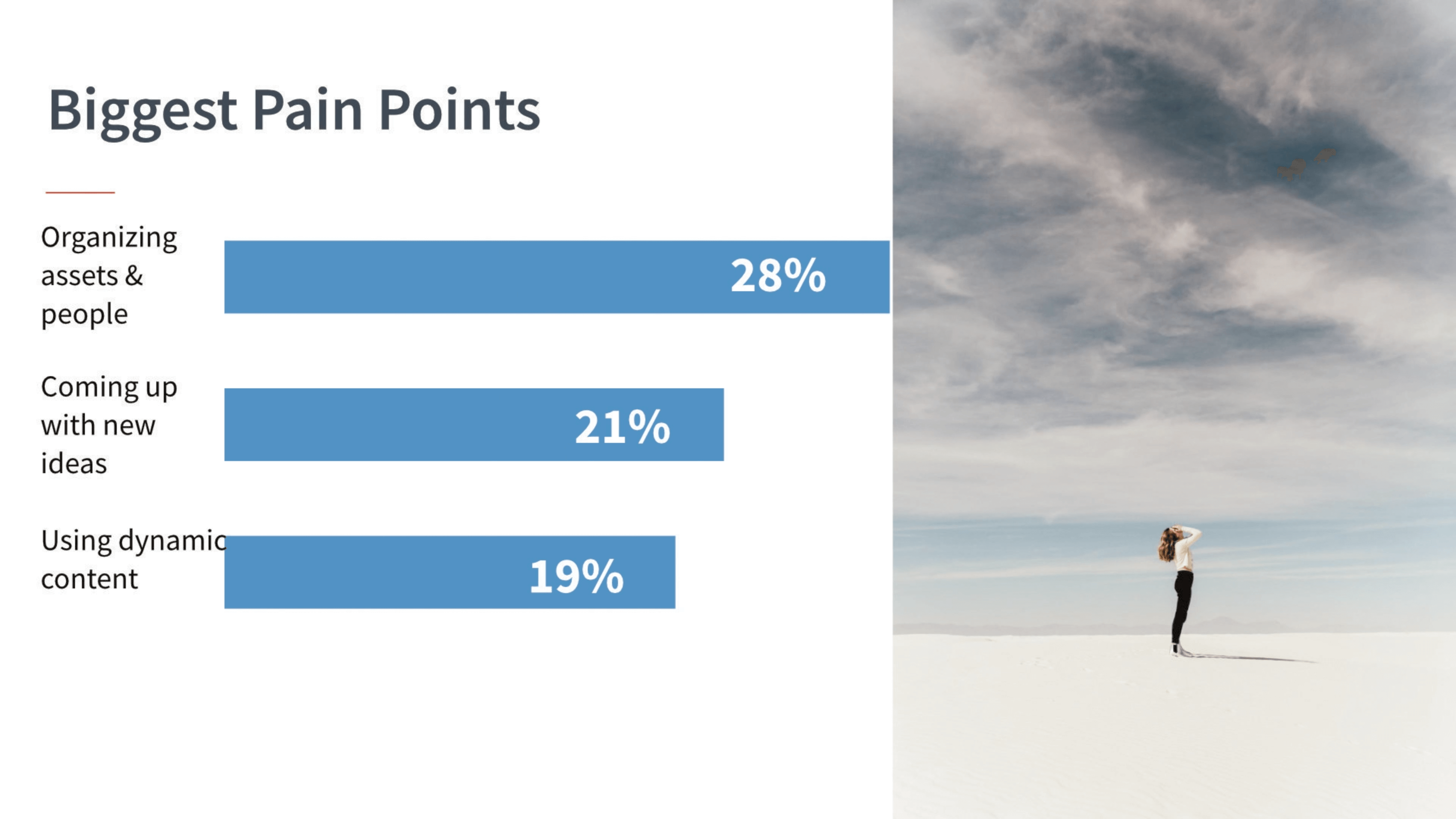
Alright. Big pain point number three, dynamic content, very challenging for sure. This leads us to our number one most impactful trend out of all 26 trends that we asked about, which was email personalization. Established, but super, super high impact.
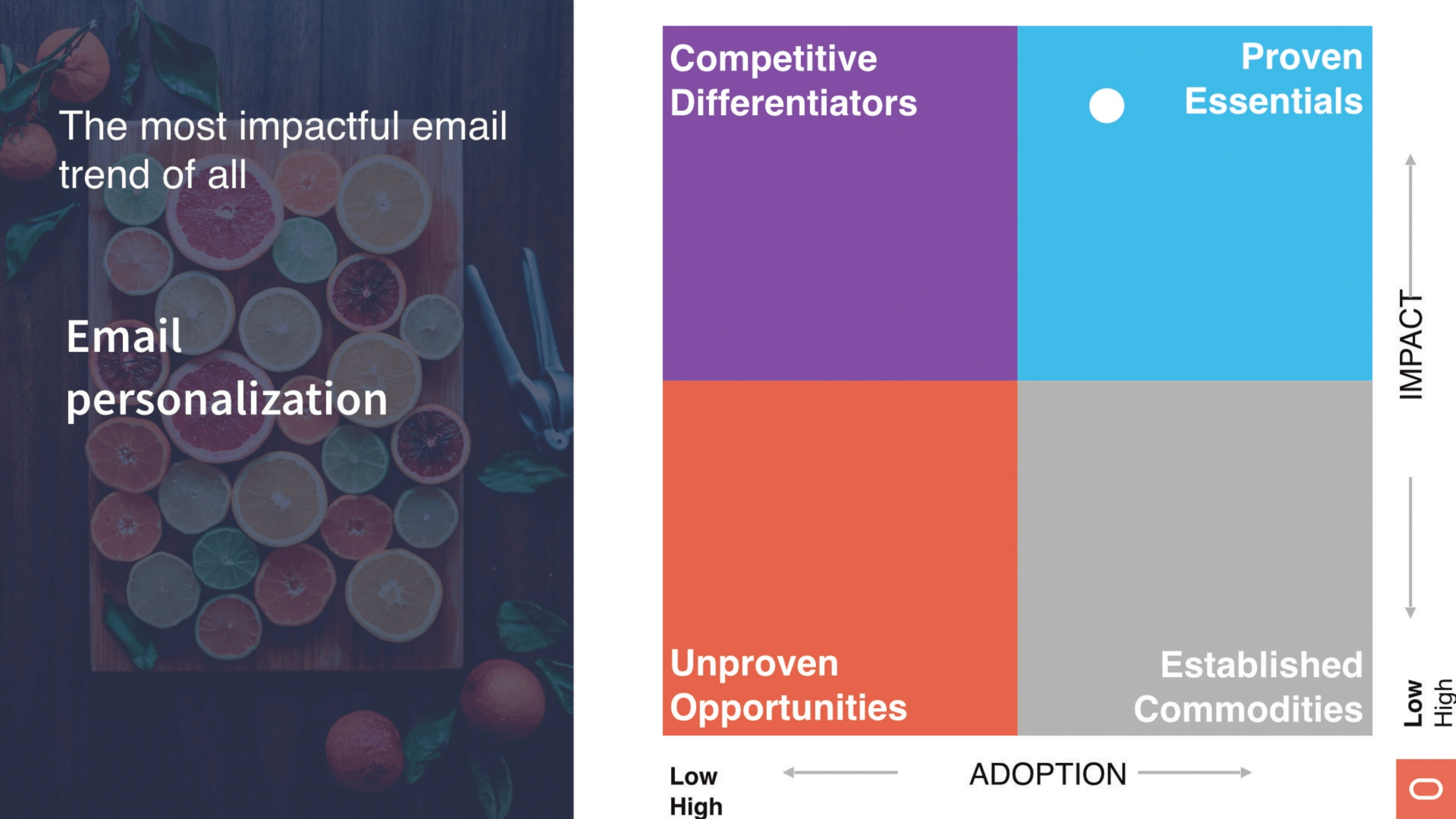
This is a trend that is what I call a long arc trend. 15 years ago when I got into this business, we were talking about personalization and it was all about first name mail merges. That's what personalization was 15 years ago. Look how far we've come. It's sort of amazing now to think about what personalization is and how first name mail merges is a joke.
You got to show you know people on a much deeper level, if you just have a first name mail merge, it doesn't mean anything. If you don't back it up with other personalization that demonstrates that know this person what they're interested in and understand their journey that they're on with your brand.
This is a longer trend that we're going to have new tools that are going to come into the system that we're going to be able to leverage and do this even better and better and better in the years ahead. AI is going to be a big part of this. So this is a trend that's going to be running for quite some time.
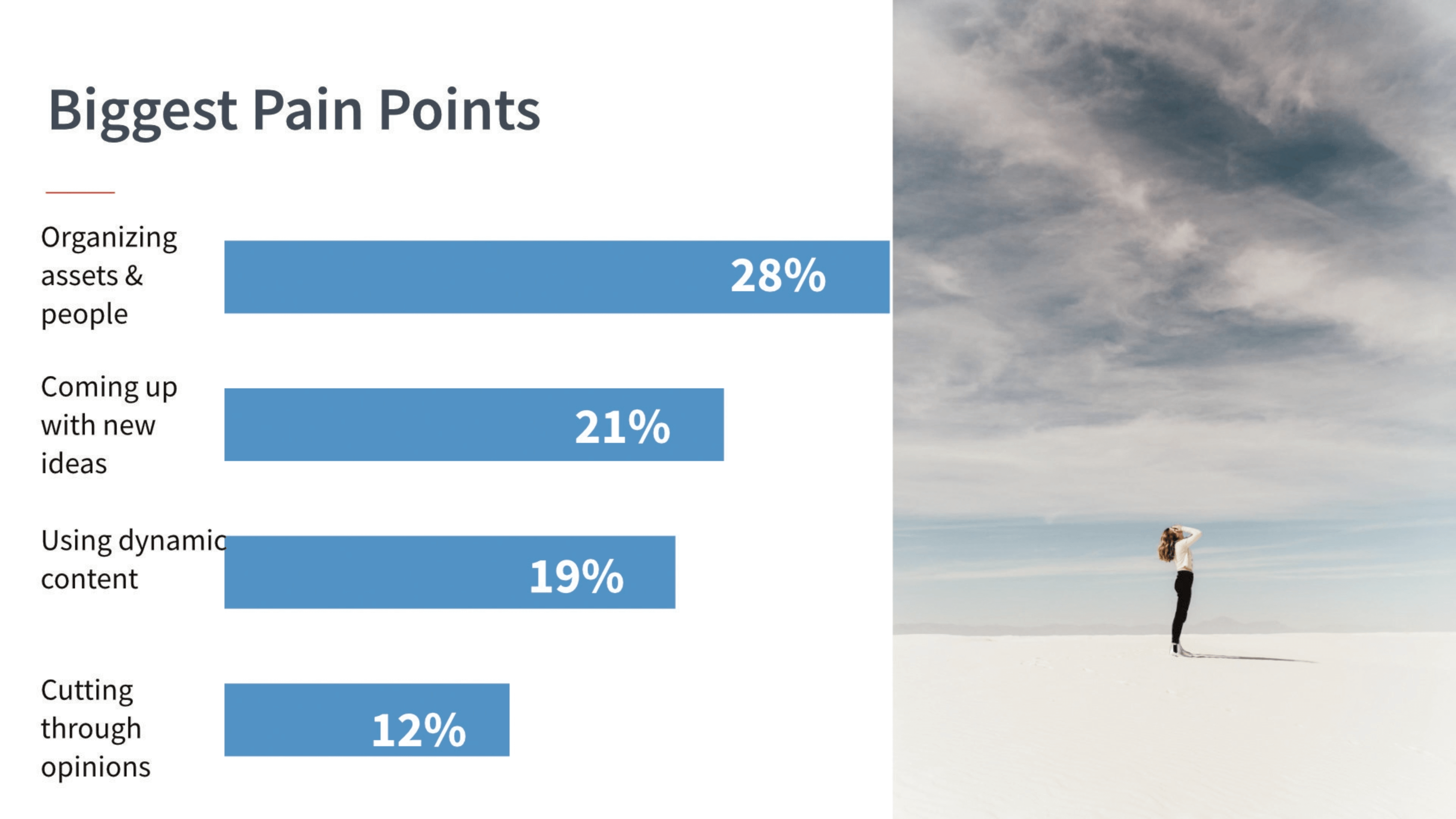
Then the fourth, the biggest pain point was cutting through opinions. Again, people, right?
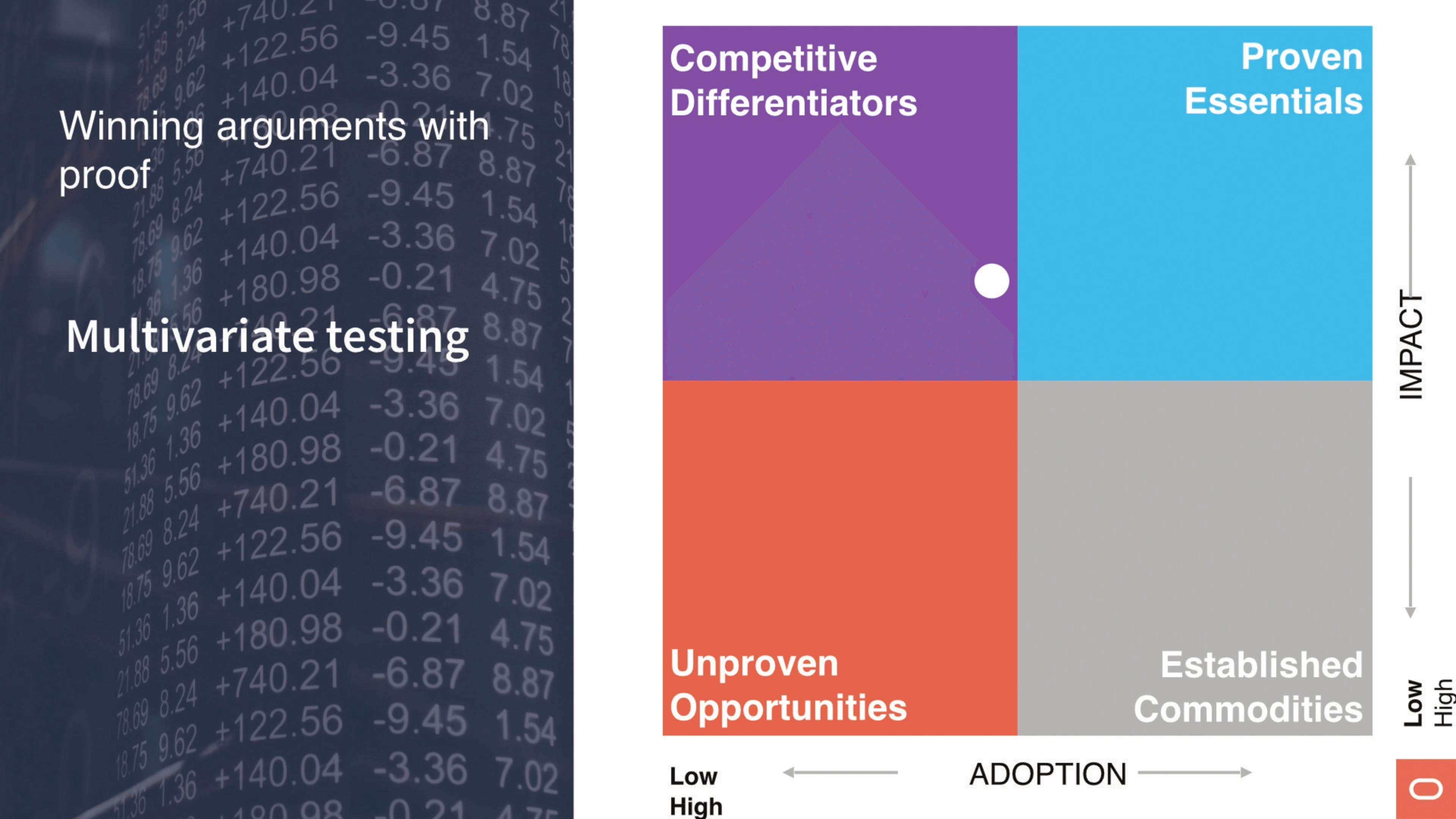
So this is where it gets tricky. I want to give you a little bit of help with winning arguments with proof. Hopefully, you're doing AB testing. If you're doing that and you are a high volume sender, you have opportunities to do multi-variate testing, which is again, that's almost sort of crossing over into, with average adoption.
If you have lots of email volume, if you have a lot of subscribers, You can have opportunities to use multi-variate testing, which means you're testing more than one variable at a time, which can be handy. If you want to test a couple of different hero images with a couple of different CTA language word choices and you can see what combination works best.
It's the combinations that make multi-variate powerful and you can't do that just with straight-up A/B testing.

Also advanced performance analytics. We are getting to the point where our analytics game is stepping up and we're looking way deeper down the funnel and across funnels to understand what are our subscribers and our customers are doing.
So these are things like subscriber lifetime value, or customer lifetime value, like revenue per email revenue, per subscriber, those kinds of metrics, which are deep and have a broader focus. That's what we're leaning more and more into, and those can also help you win arguments.
If you have that kind of data available to understand if you tweak this part of the journey, what does that do in terms of the ripple effect that it has later on? Some of these changes may look good just in isolation, but then when you put it in play everything that's going on in that journey, it can have negative downstream effects.
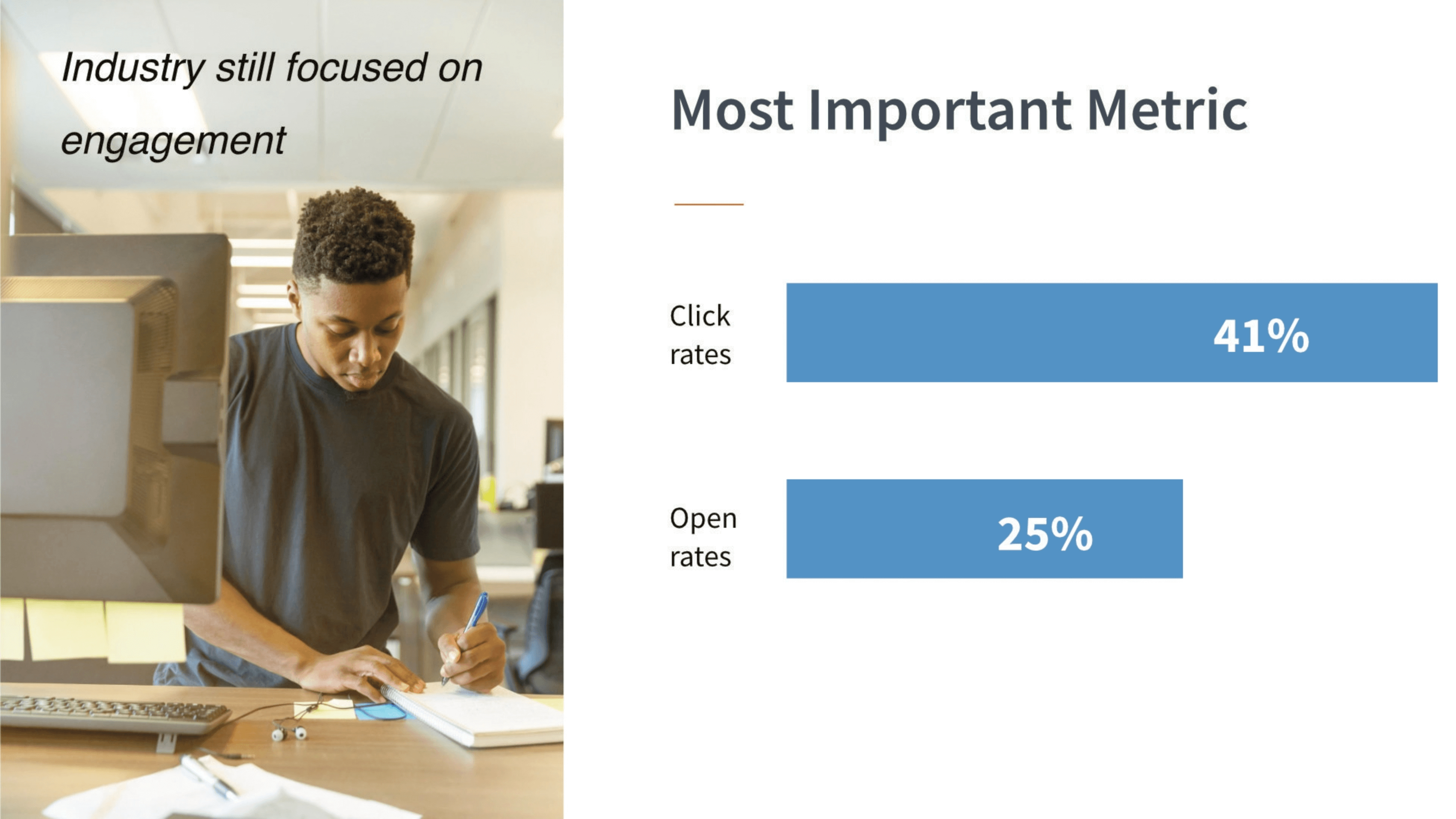
Alright. So speaking of metrics, Really Good Emails asked you what your most important metrics were. 41% of you said clicks, which made me decently happy. Clicks are a good place to look. I was a little bit sad that 25% of folks were saying that open rates as their number one. Had to wipe away some tears when I was looking at this data.
I would encourage everyone to look deeper down the funnel. I mean, opens are important. It is a way to gauge engagement. But it is not such a great metric because boosting your opens doesn't always lead to longterm success. You can do "openbaity" subject lines that can boost your open rates temporarily.
You're trading away your brand respect and trust. So you need to be careful. I always like to look lower, and this is especially true with subject lines. I think this is where some of this misunderstanding comes from is that a lot of people still think that the whole point of subject lines is to get opens. It's not true.
When you test your subject lines, your open rate is not your success metric. You need to use metrics that are further down because the whole point of a subject line is to get the right people to open your email. You can't tell if you've gotten the right people to open your email, unless you're looking at clicks or conversions further down. You don't want to just get anybody to open your emails. You want the right people. People who have an alignment with the message of your email. So always be looking deeper down if you can.
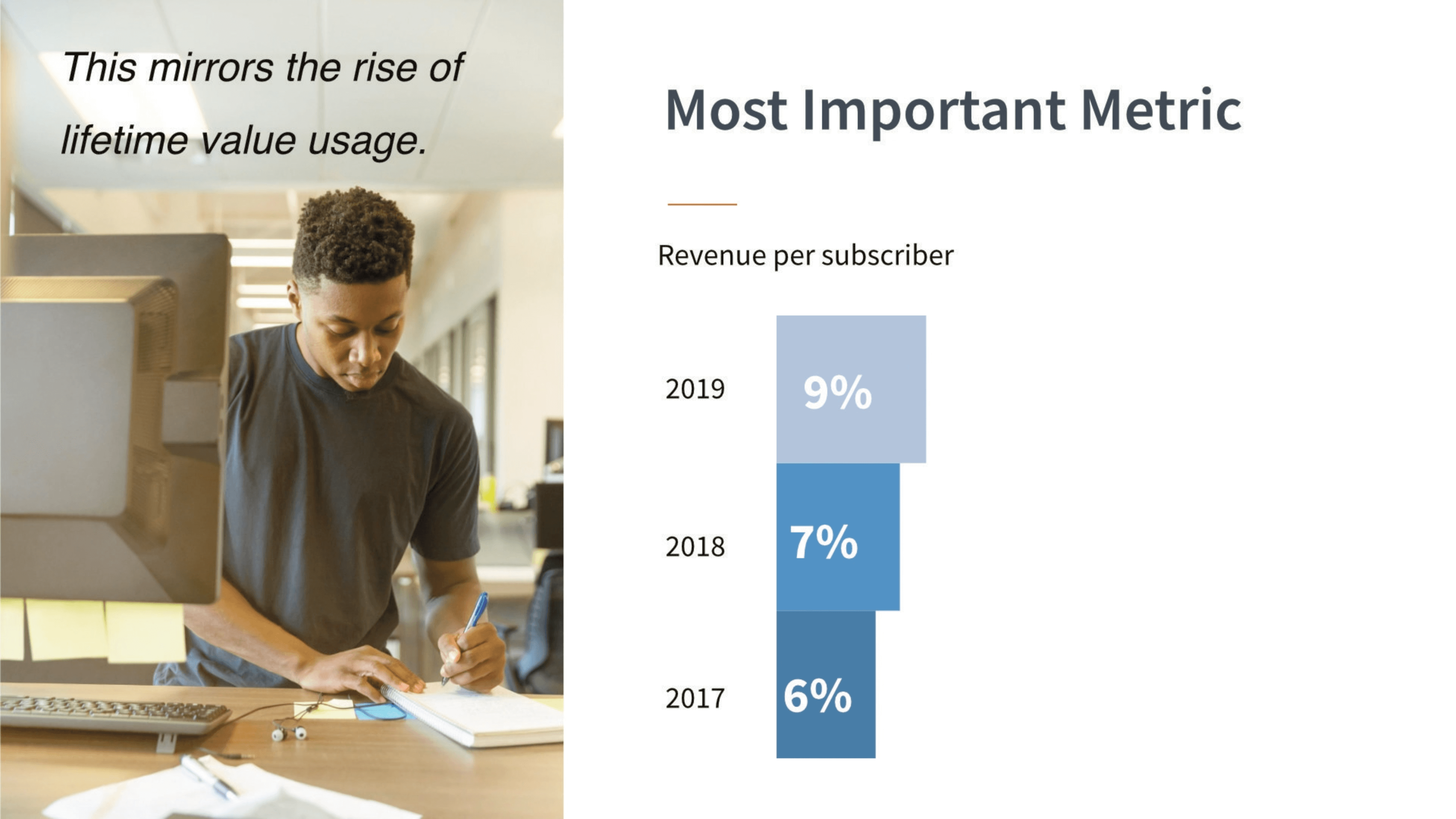
Still a lot of focus on engagement across the industry, but we are seeing a little bit of a turning of the corner a little bit. So for instance, revenue per subscriber, this is a metric we've have seen more and more respondents saying that that's their number one metric.
That is good to see. The use of that metric paralleled the use of lifetime value, which is also great to see. So some of your peers are getting on the track. It's not easy. Some of you are probably thinking like, well, the point of my program isn't to generate revenue it's to generate engagement.
In that case, I would encourage you to think about revenue proxies. If you are, for instance, a subscription-based company your email program is probably about retention. It's probably keeping people engaged and using your platform so they don't cancel. You can probably calculate some type of a proxy about folks who are X engaged with our email program they cancel at a much lower rate than people who aren't engaged.
You can turn that into a revenue formula. Which is good for you to be able to tie your work back to revenue whenever possible. I would encourage you to think about, are there proxies that you can set up where you can draw some dotted lines to the behavior in your emails to what that does to revenue for your business, whether it's through retention or something else.
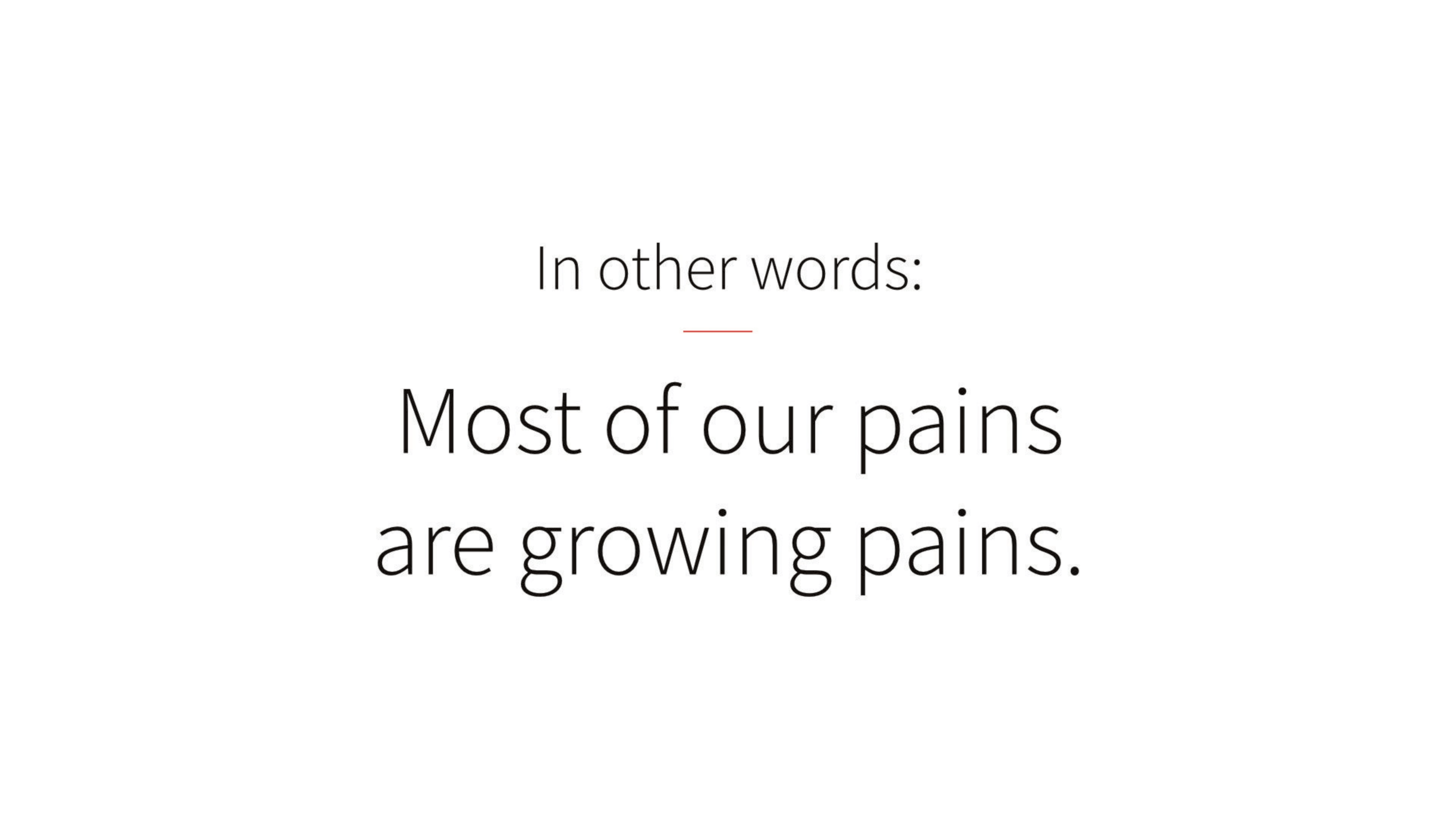
Alright, so in other words, we have a lot of pains, but I think that they're mostly growing pains. We're a growing industry, we're an evolving industry and change is hard. But I think all of these changes are positive.

Let's talk about workflows.
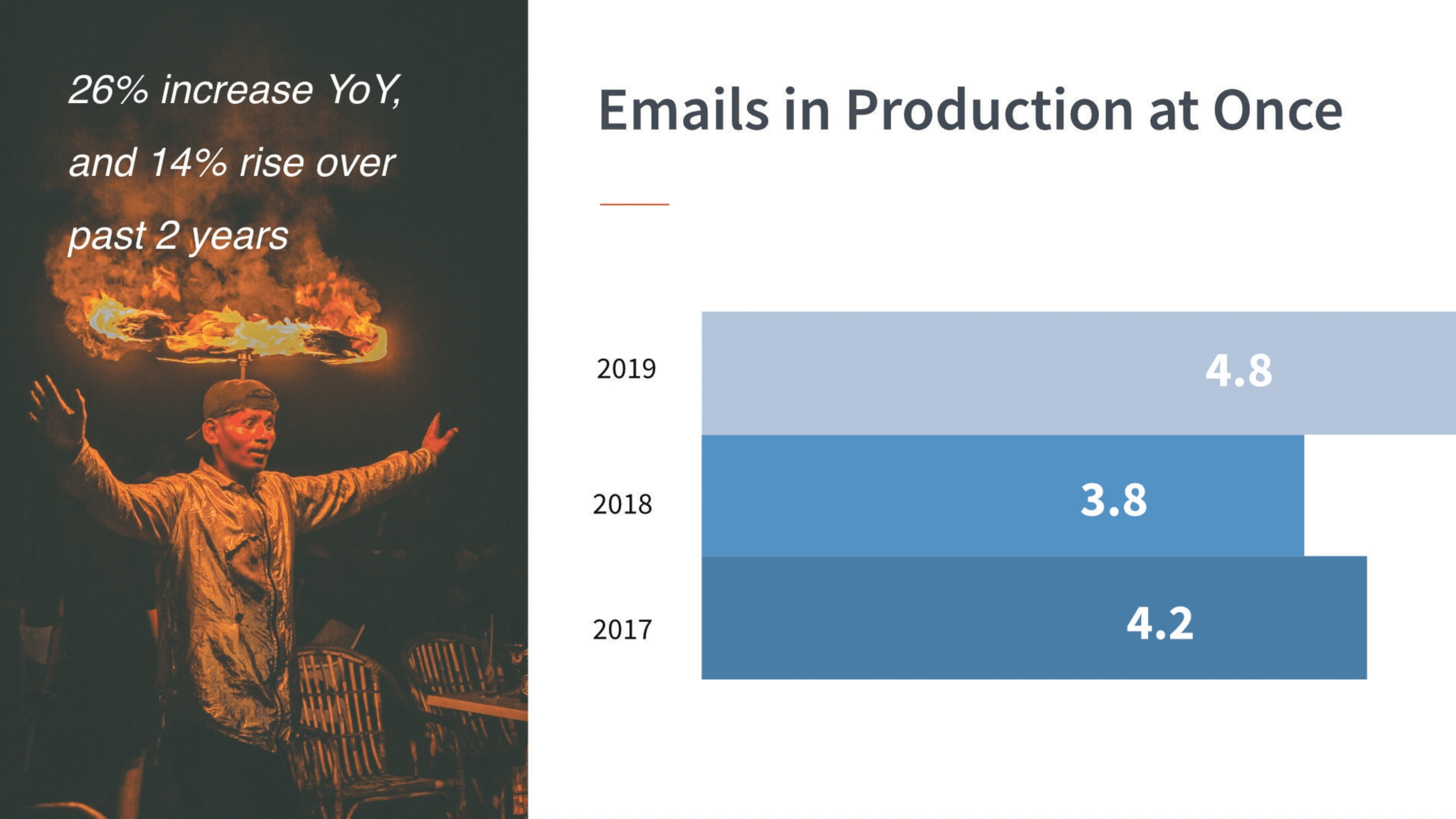
Last year, there was an image of a guy like twirling, like a fiery baton, so we upped it this year, spinning fire hat. You have more emails in production at once. You are juggling more emails in production. 4.8 on average. Year-to-year, it looks a little scary. I don't think that trend is going to continue as a 26% year over year increase, which seems a little unsustainable to me. But if you look over the past two years, it's only 14%. So maybe not quite so dire.
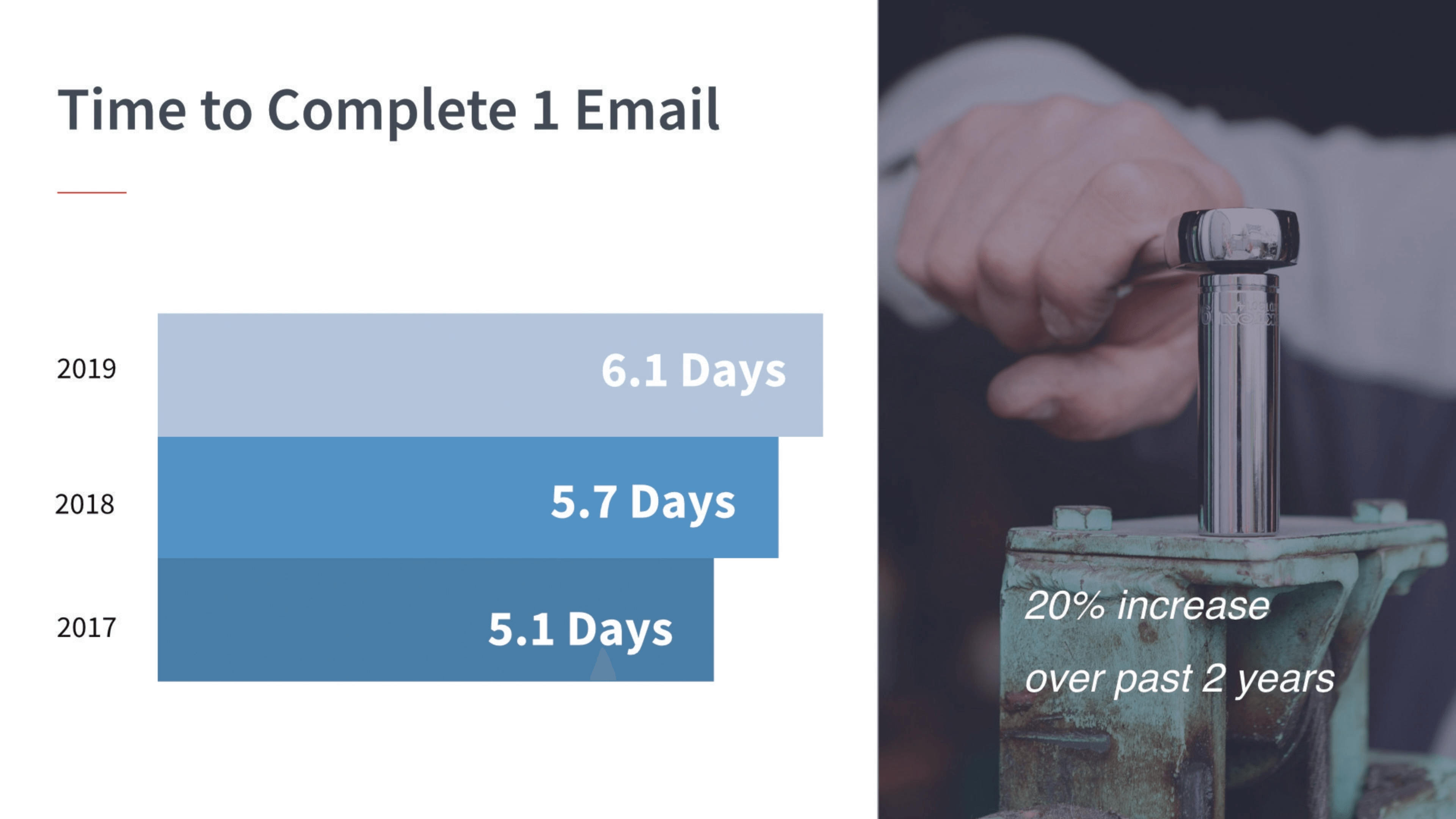
At the same time, it's taking you more time to complete each email. A little over six days per email and that's up about 20% over the past two years. A couple of rather daunting figures where you're juggling more emails at once and it's taking you longer to produce each email. It's a tough place to be.
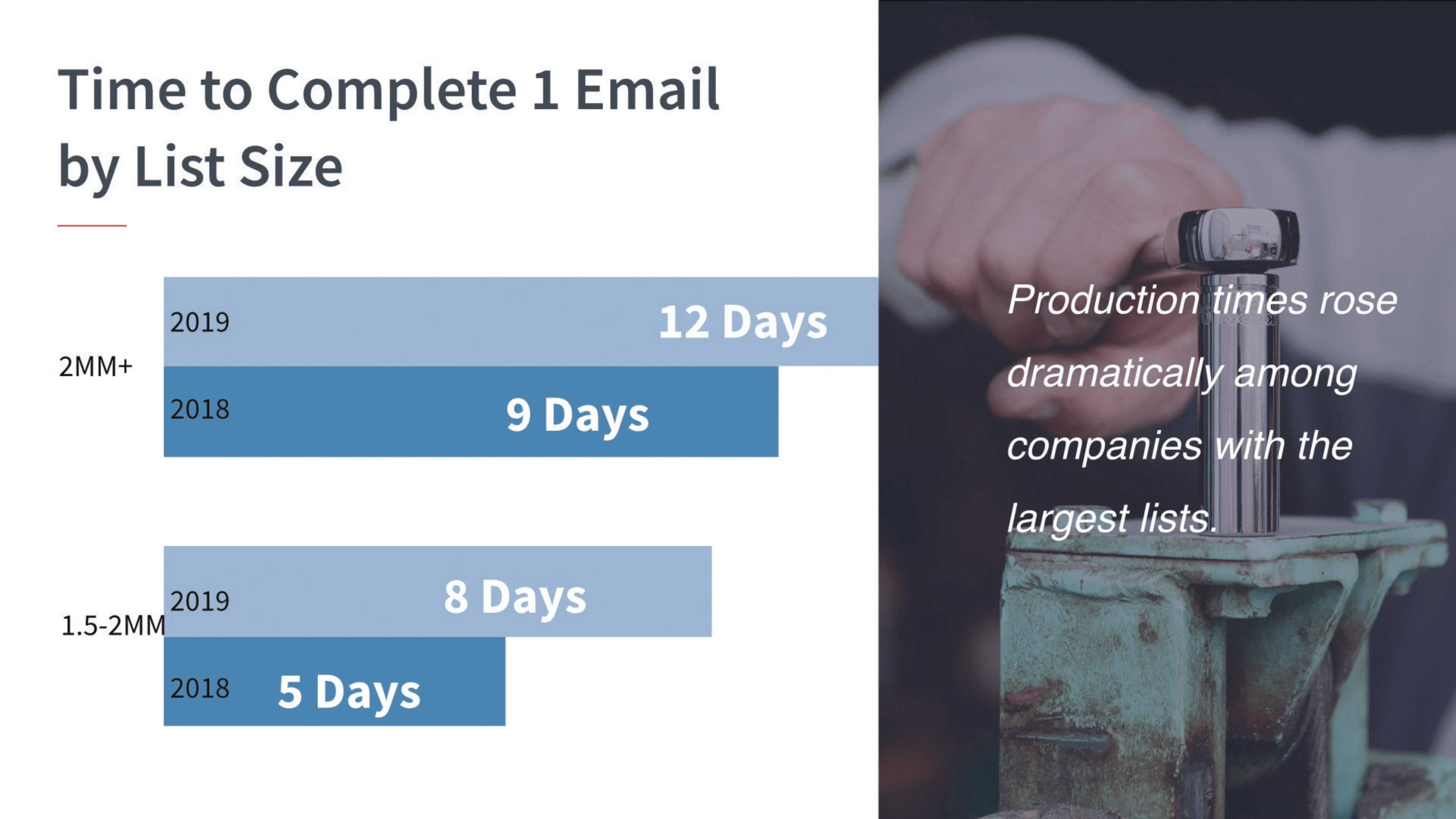
List size is impacting this equation in a big way. If you are at a larger brand where you have lots more subscribers, you already spent a lot of time making your emails and it got significantly worse over the last year. So folks we had over 2 million subscribers on your list. Those folks went from 9 days to create an email to 12 days. So pretty significant growth among larger lists. At the lower list size part of the spectrum, we saw that production times didn't change very much. They were pretty much flat, but at the upper end, things got even more difficult. I'll explain why in a second.
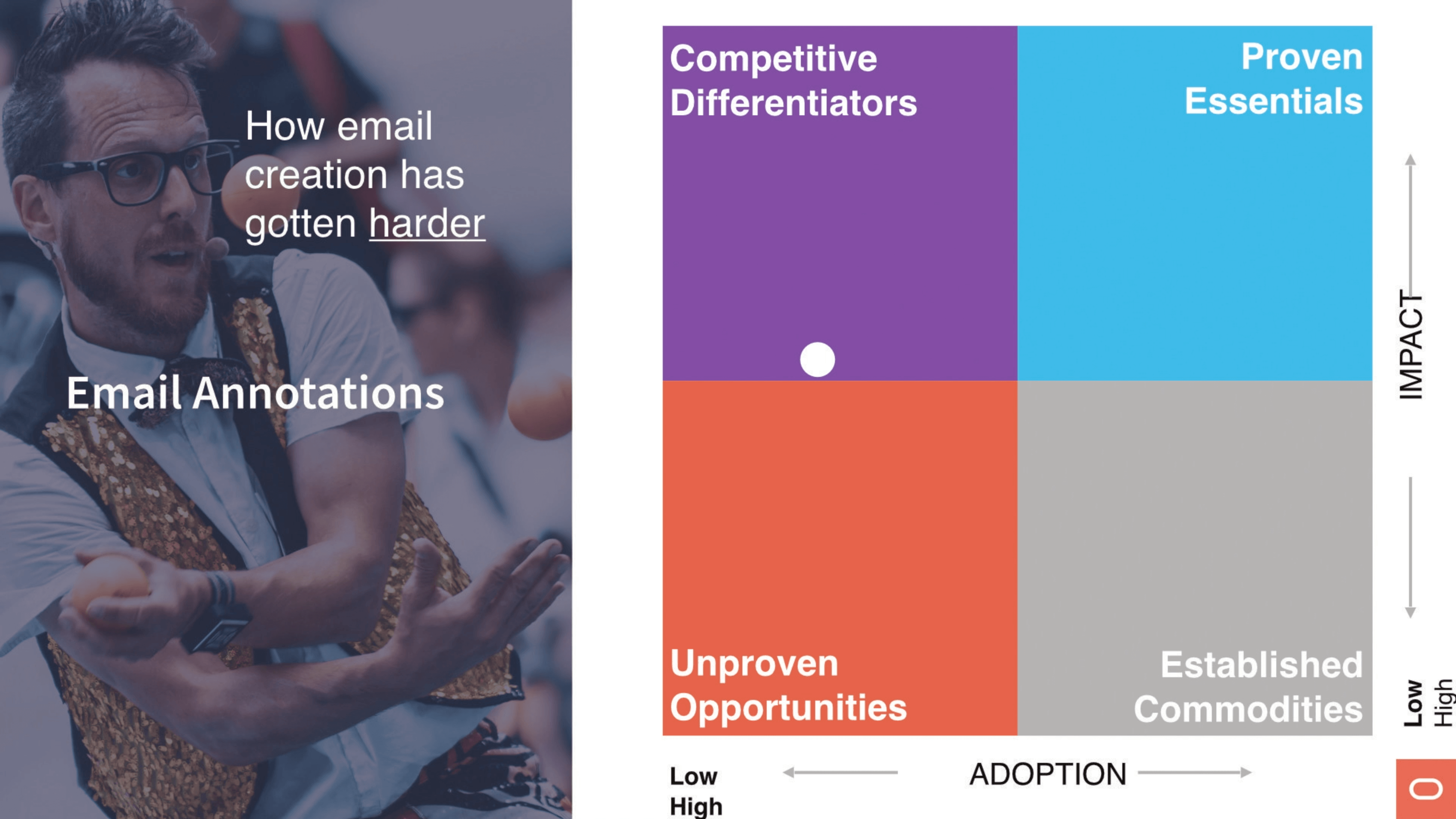
There are lots of ways that creating emails has gotten harder over the last couple of years. First email annotations. This is the new Gmail functionality where you have to code in special code into every single one of your emails to be able to take advantage of special preview text that populates in top deals.
Under certain circumstances for certain centers at certain times, lots of caveats there. We recommend that everybody use this, but the part that we recommend that everybody uses is the part that allows you to populate your logo. Everything else we think is sort of a game-time decision, depending on your brand, but if you are trying to make full use of email annotations, that means you are adding special code to every single one of your emails. That is additional work.
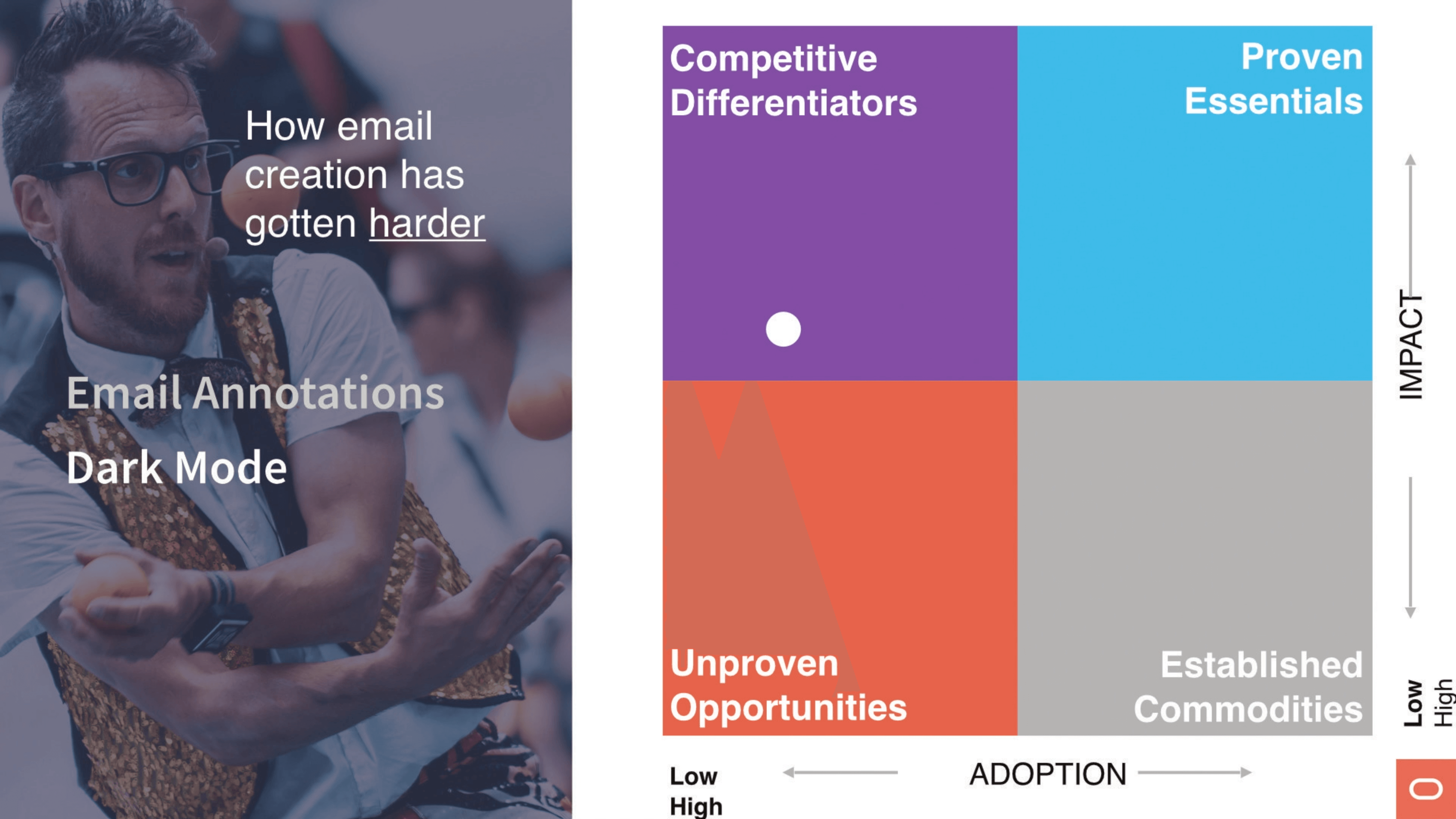
Dark mode. Dark mode is a pain in the butt. We've been optimizing a lot of our client's emails for dark mode. Recently we're optimizing our own Oracle CX marketing consulting newsletter for dark mode. We made a bunch of changes and we're happy with it and then Litmus put out Office 365 on Windows 10, which looks like garbage, like destroyed our emails because we have background images. So back to the drawing board there. Dark mode is a challenge. We made a bunch of changes to our emails. Recommend everybody to take a look at that as well. See what you can do without going crazy.
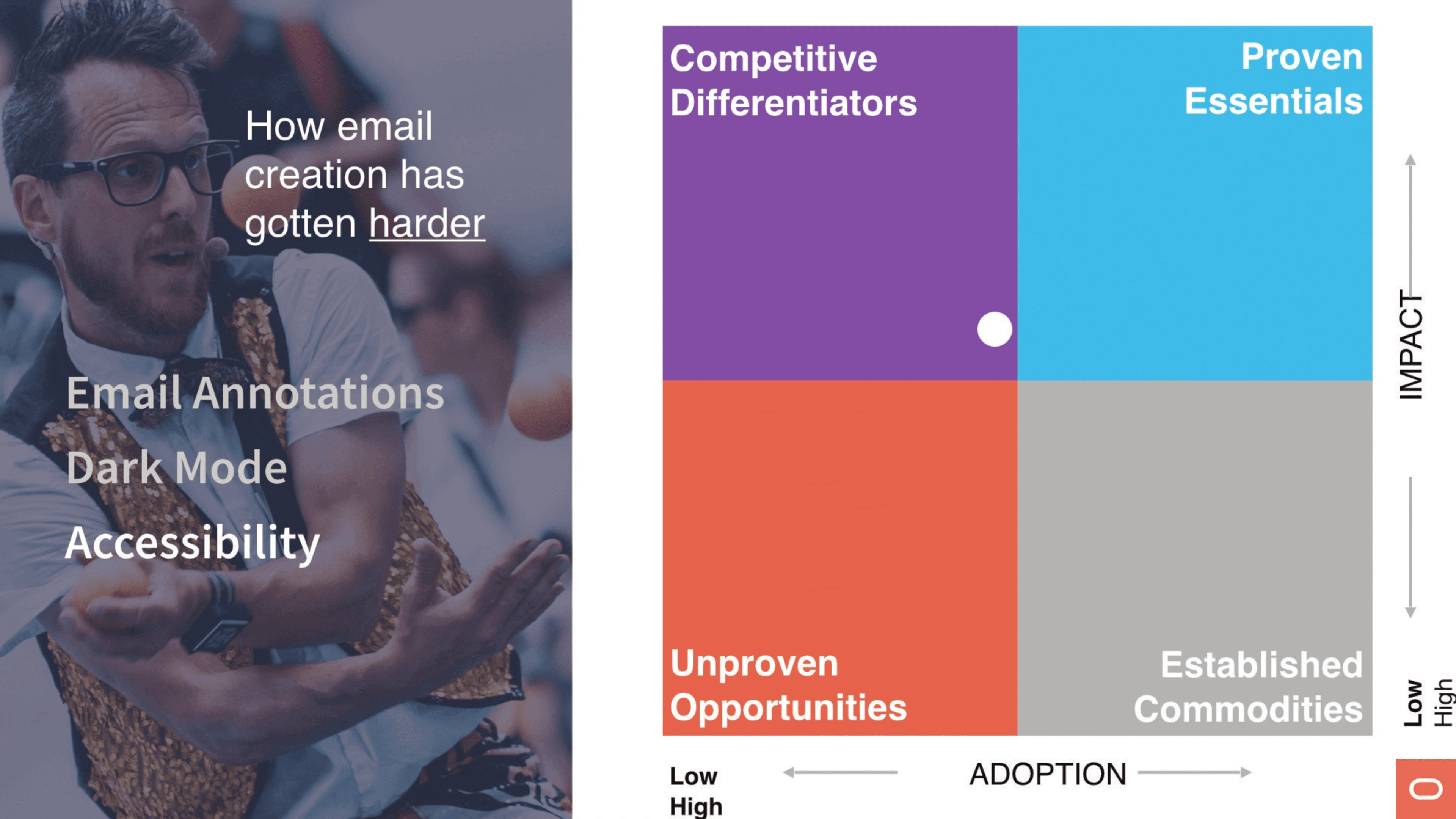
Accessibility. Which, in some cases aligns with dark mode. I know that we increased, some of our contrast ratios for dark mood using pure black fonts or pure white fonts, whereas before we were hedging.
Having good contrast for folks that have vision problems or for just normal run of the mill people who are out in bright sunlight with their mobile phones. Good high contrast is good for everybody. Doing some colorblind tests and stuff. There's additional testing that has to be done to make sure that you're having an experience that works for as many people as possible. It takes some extra work.
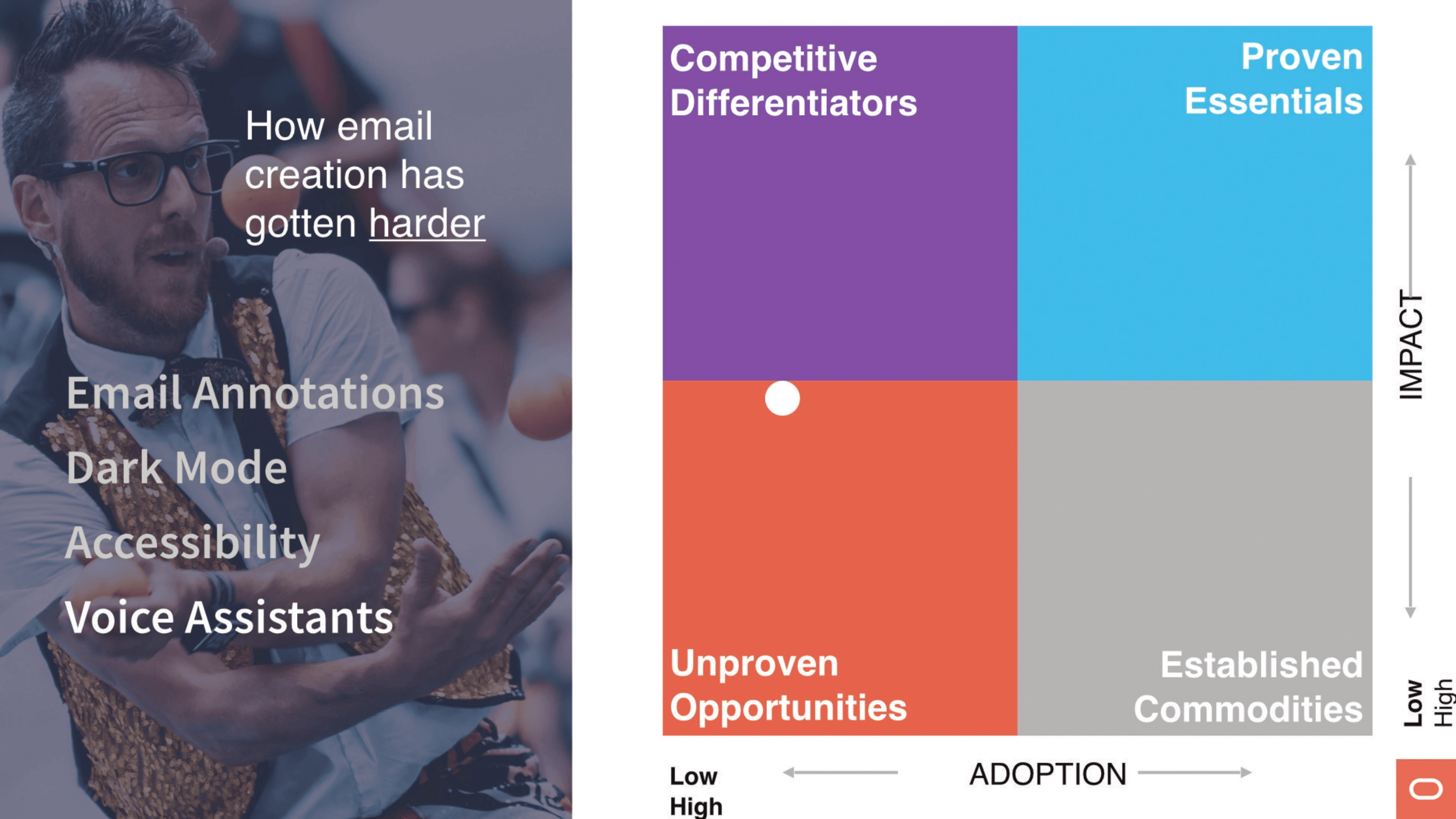
Voice assistants reading emails. This is a sort of a very new thing that's probably a bunch of you aren't seriously thinking about. Here the challenge is that we've spent years and years and years perfecting visual communication with our email and now our emails are being read in some cases and they sound horrible because we use creative punctuation, creative spacing, creative spelling, use emojis, which if you check most emojis have crazy names.
You got to be careful. You don't want that to be read out. It doesn't sound good.
My short advice is that people are not going to be just using voice assistants to engage with your emails, because it's impossible to engage with your emails. After all, there's no browser to click through to. So most of your CTAs are garbage and aren't going to help them. So all they're going to do is triage their emails with voice assistants if they're doing anything. In much the same way that people use smartwatches to triage their inbox. They're not using it to engage with your emails.
Smartwatch is a great analogy. It has no browser. You can not click through. You can not take action on a smartwatch. Voice assistants are the same way. So my advice here is to think hard about your subject line and your sender name and your preview text and see if you can get that to be a little bit more voice friendly. That's the thing they're going to be listening to decide whether or not to delete your email or to hold on to it and look at it later.
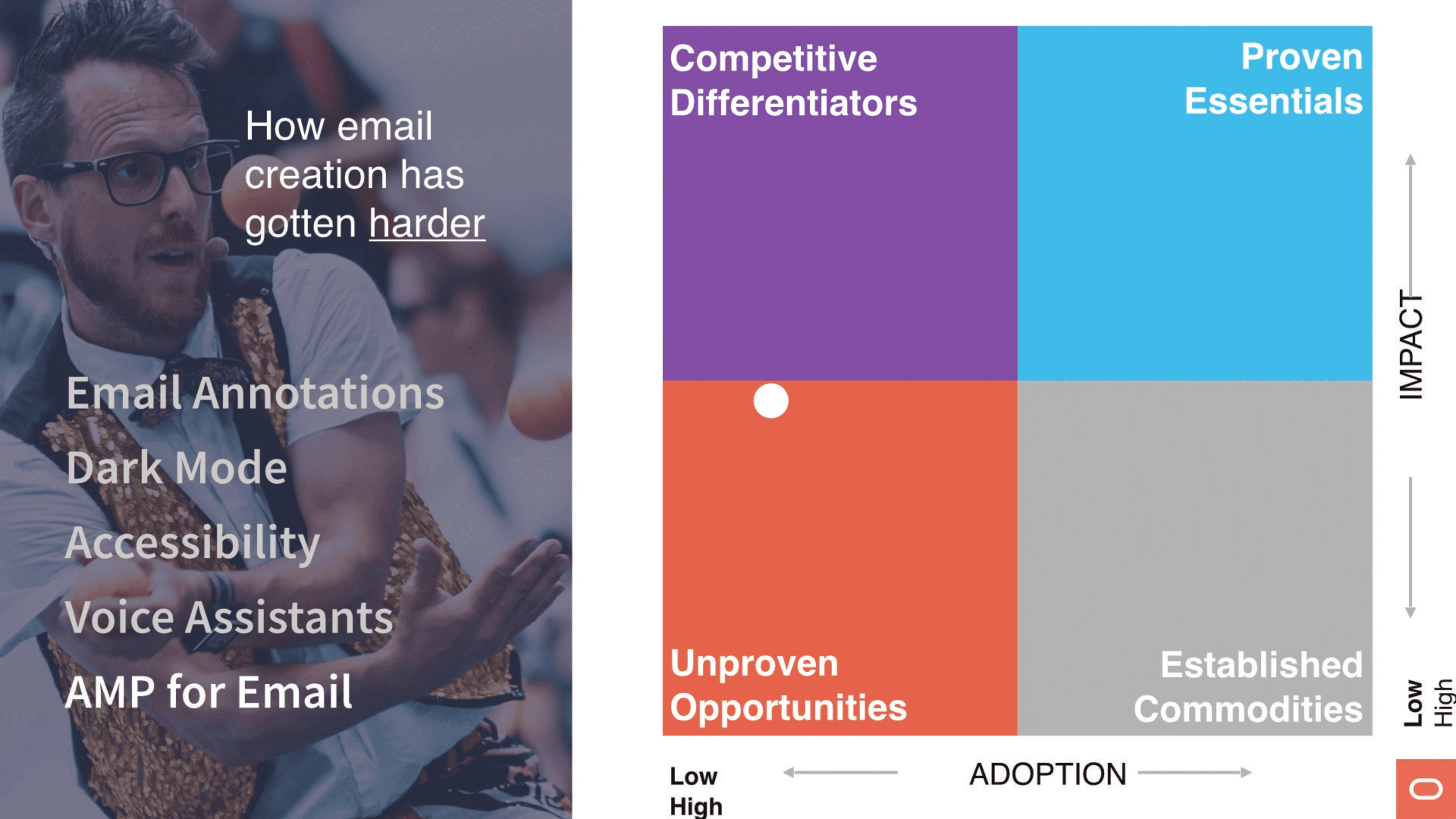
And then AMP, we could spend a whole session on AMP for sure, but the challenges here are that you have to create a brand new email that sits next to your plain text and your HTML email. You have to learn a brand new coding language. More time to have this sort of enriched experience inside Gmail.
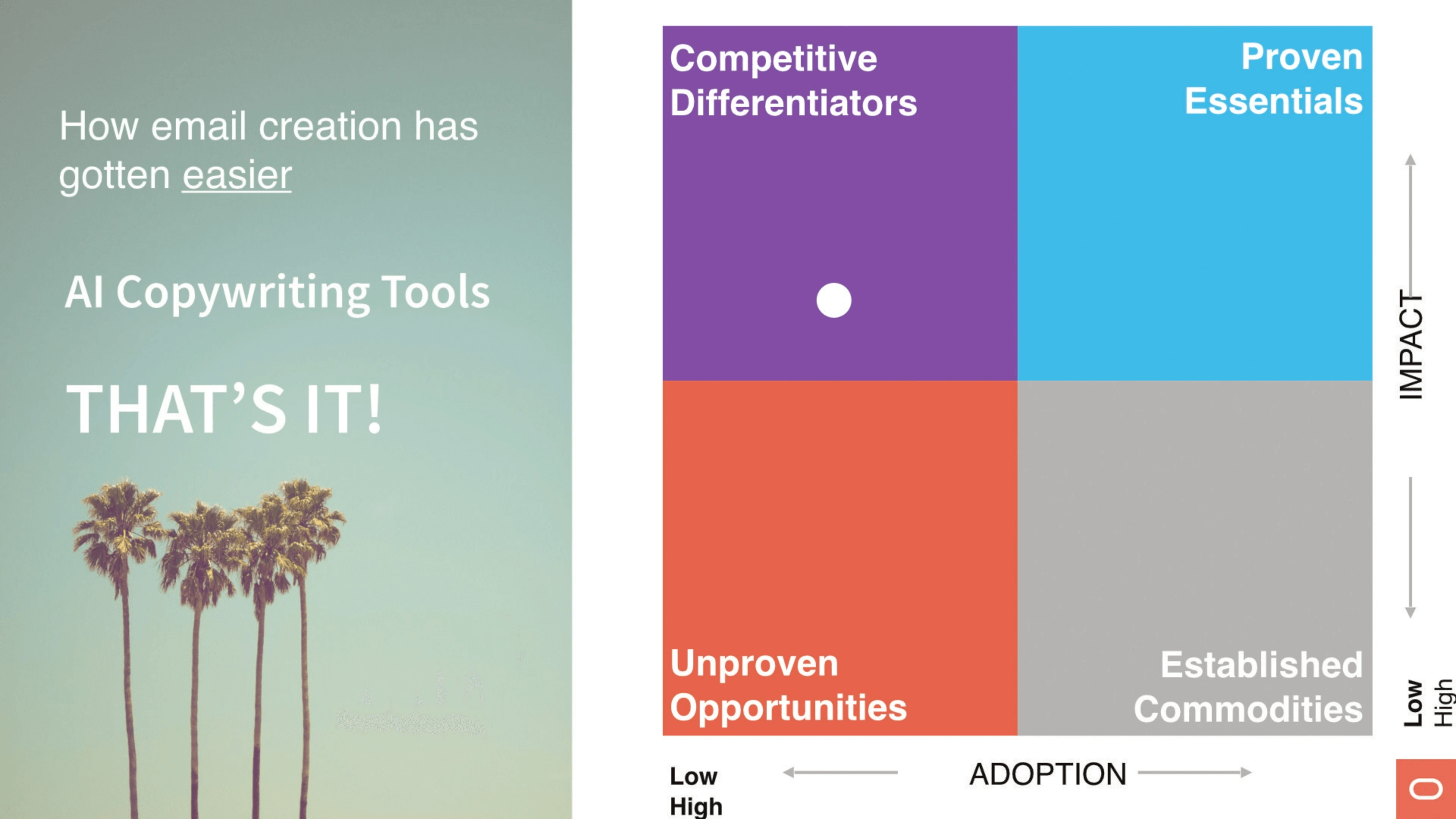
So those are how your jobs have gotten more difficult. Let's talk about how your job has gotten a little easier. The first one is AI copywriting tools, which I will admit is a little bit of a mixed bag.
Our clients have had mixed experiences with it. Sometimes they see lifts that don't last for more than three months. That's a bad sign. That's a sign of gamesmanship. That's not what you want. You want lasting lift, meaning that you're generating real positive engagement and not this sort of gamesmanship.
I think longterm this can be a way to get new ideas. Think about language that you hadn't thought of. So it can be a plus. So that's the first one and that's it. That's the only way in which your jobs have gotten any easier at all. Everything has gotten harder. So it only makes sense that the amount of time we're spending on email has gotten longer.
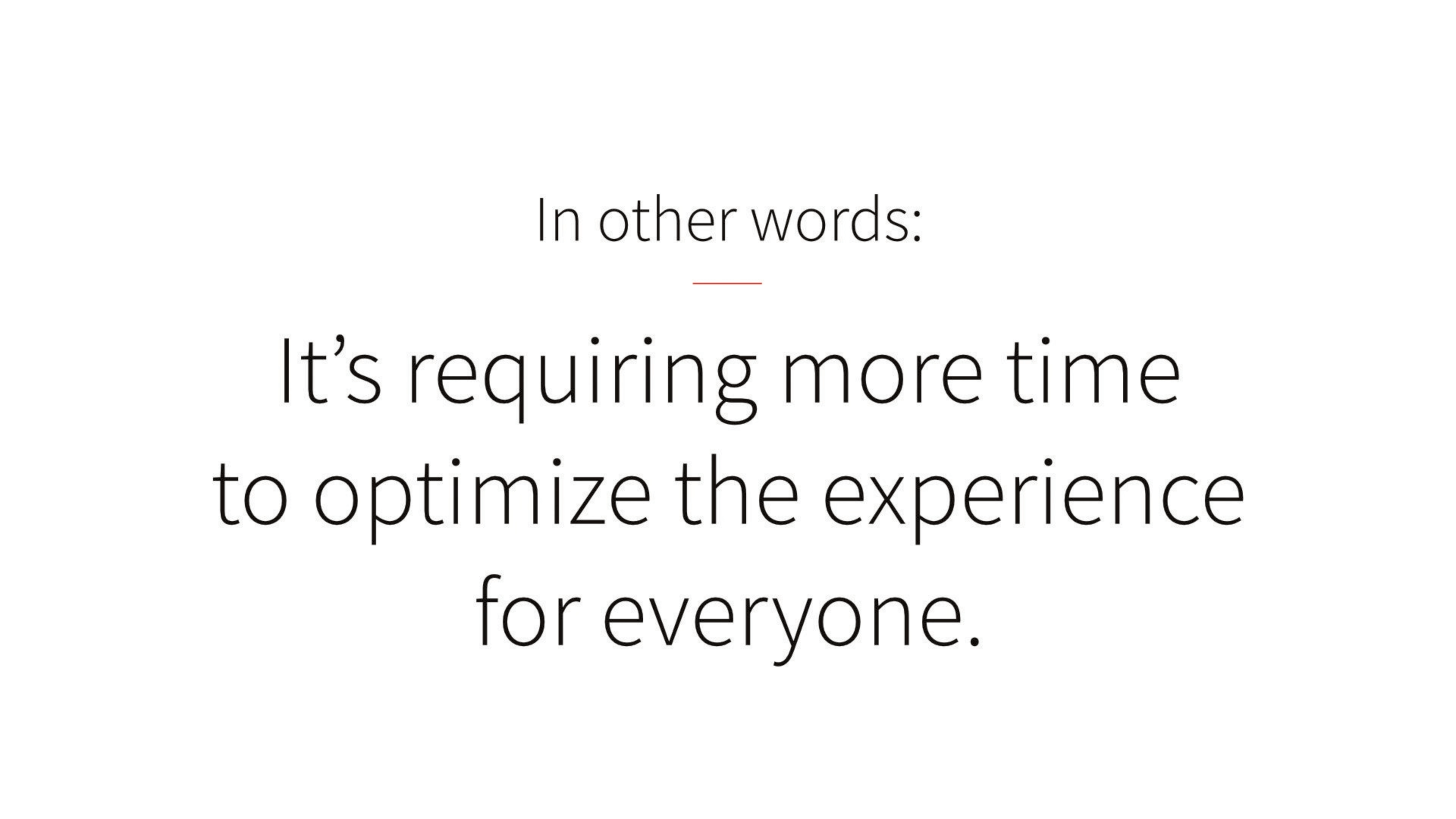
It's taking us longer to optimize the experience for everyone because everyone used to be more monolithic and now we're getting smaller and smaller chunks of our audience that we're having to tailor to. Tailor to those folks in Gmail, tailor for those folks who are using dark mode, tailor to those folks who are using voice assistants to listen to our emails.
So our audiences are becoming micro audiences or sub audiences that we have to pay attention to. If we're trying to create an optimal experience for a vast array of sub audiences it's going to become more challenging. Unfortunately, I don't think this is going away.

Let's talk about some tools. Let's talk about ESPs.
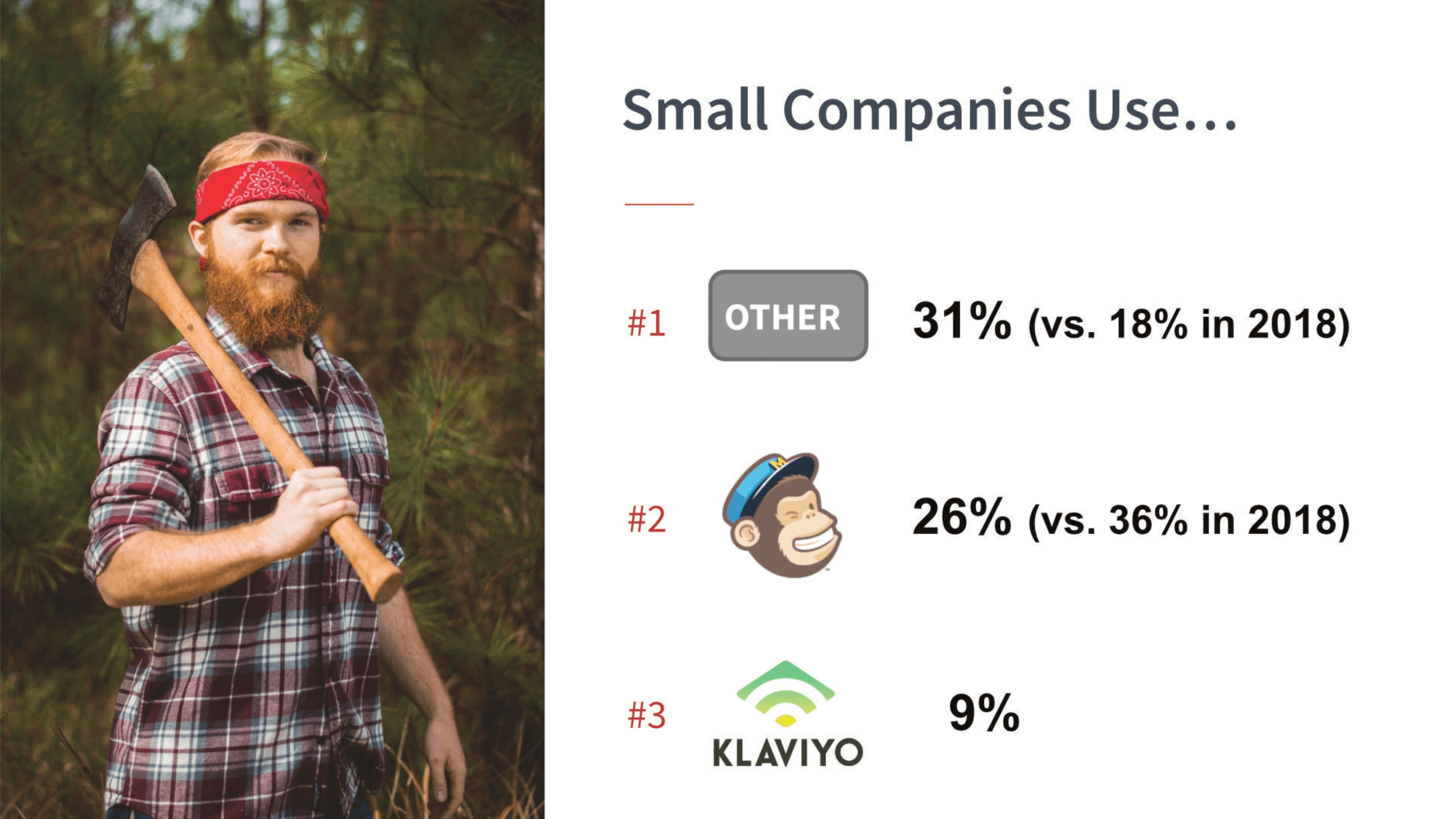
The ones that small companies use. Coming in at number three is Klaviyo and number two Mailchimp. This is slightly misleading because number one is everybody else.
When I was at Litmus, we did a similar survey about ESP usage and we allowed people to write in and tell us who they were using if it wasn't one of the ones we gave them a chance to select. And along with everyone that they could select all the major players and all the write-ins, it was over 240 different ESPs that people were using.
So there is a lot of choice. Particularly at the lower end of the market. So if you are a smaller house, you have a ton of choices. A ton. Probably, let's be honest, too many choices. But there's a lot of choice for you. If you don't like what you are using, you have opportunities to go elsewhere.
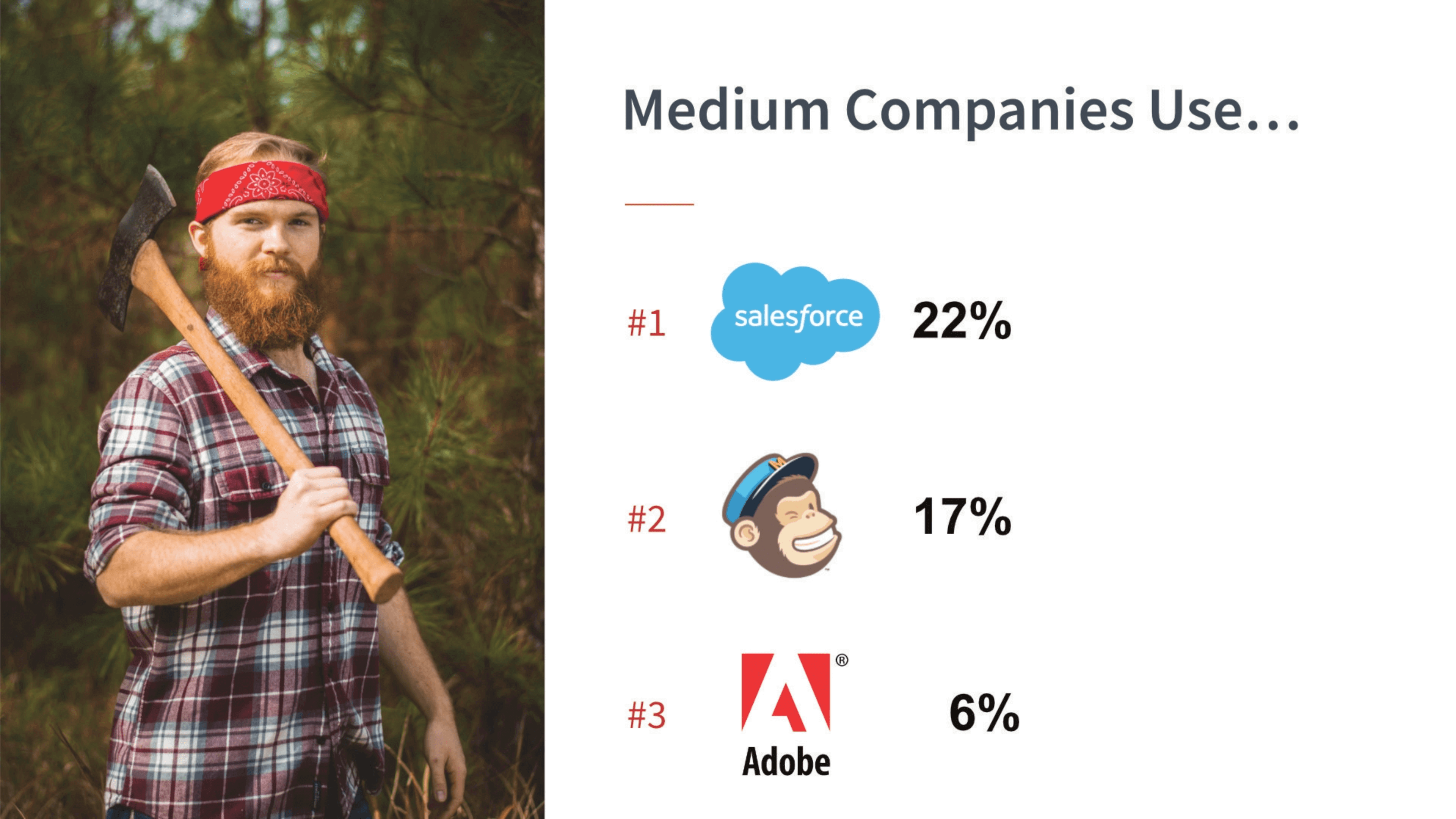
So for you, medium-sized companies, number three, Adobe. Number two, Mailchimp. And number one was Salesforce.
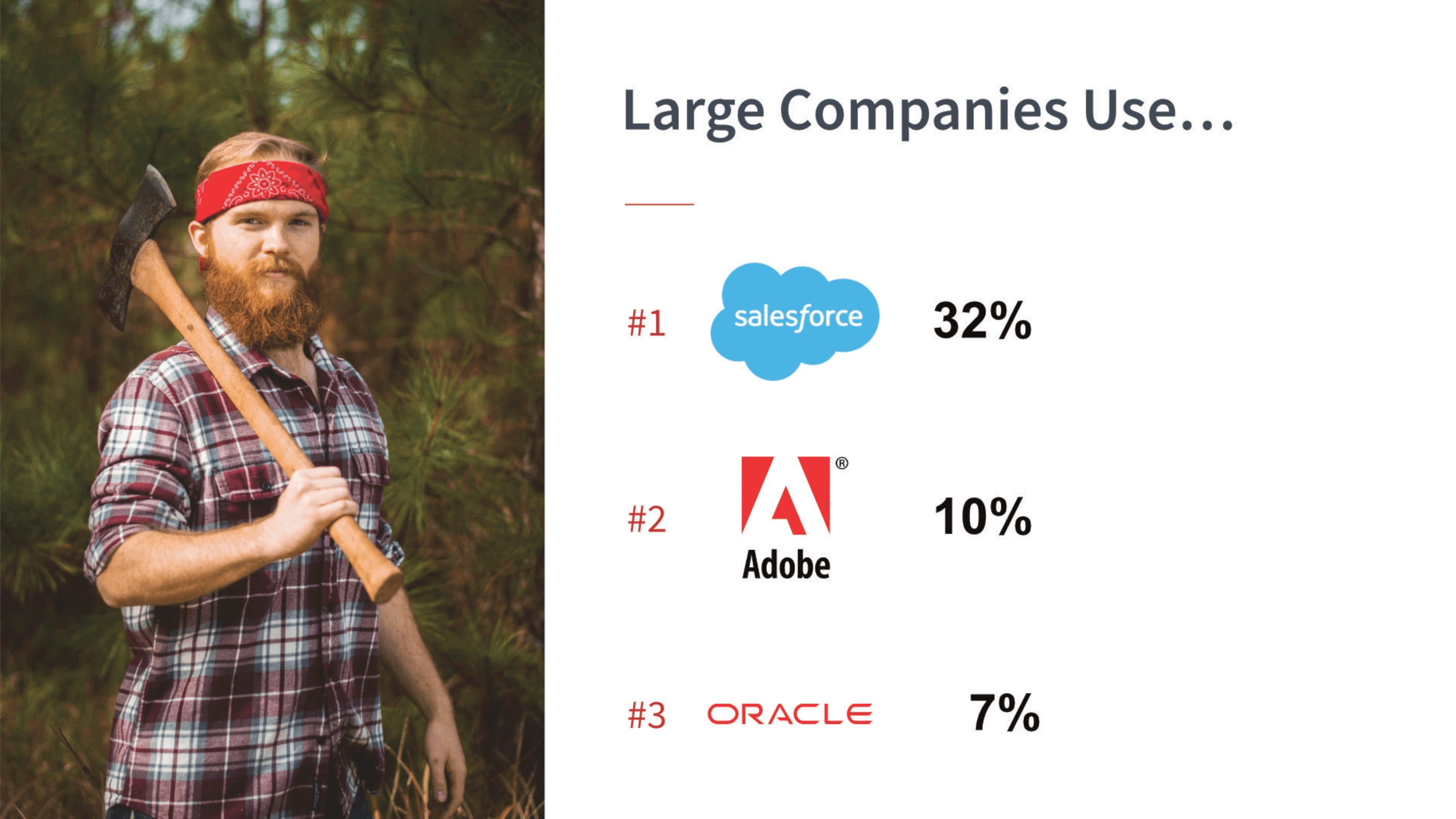
For you, large companies, number three was Oracle. Number two, Adobe. And number one was Salesforce.
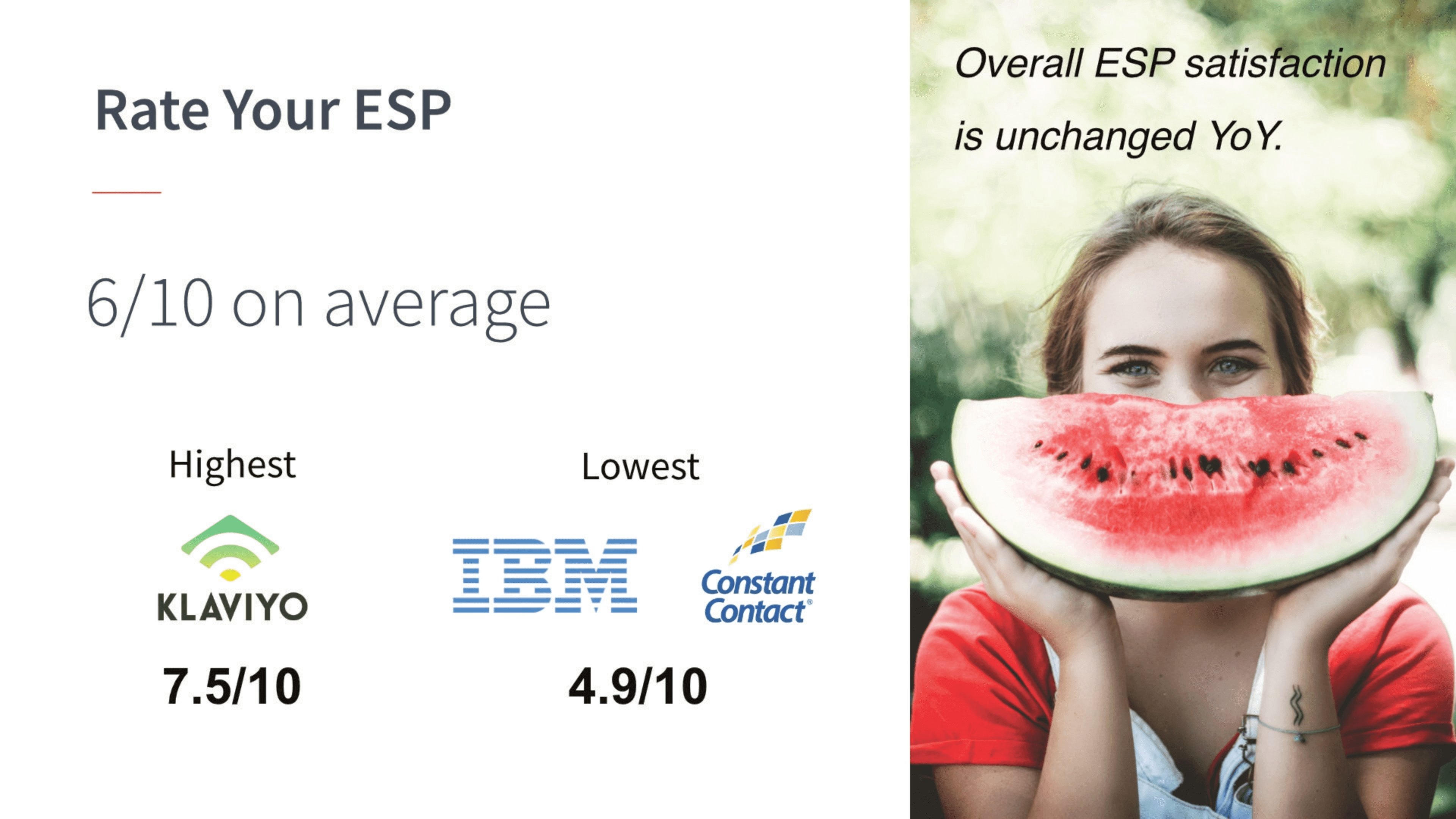
In general, people were not super thrilled with their ESPs. On average, a 6 out of 10. I don't believe this question was written in a net promoter score way. I think it was like, are you happy? It's hard to not view it a little bit as an NPS. So not a ton of happiness.
Year over year, it didn't change at all. So last year it was 6 out of 10. This year it's 6 out of 10, but I do want to give you a bit of my perspective on this. So at the high end, with Klaviyo at 7.5, which is on an NPS score, still neutral. So this sort of says that nobody's happy and if nobody's happy, then you got to adjust the scale a little bit.
Then the lowest was IBM and Constant Contact. IBM's not surprising since Silverpop got divested and they got spun off to a private equity group, which means that probably in a year or two, they're going to get sold again. So there's a lot of uncertainty there. Uncertainty makes people unhappy.
There's still quite a bit of uncertainty in the industry in terms of who's going to own what. Things are still kind of settling out. There's still quite a bit of buying and selling going on. Lots of mergers and acquisitions. That's going to make people unhappy and uncertain about the future. I think that's part of what's going on, but again, if you look at this, if the lowest is essentially 5 and the highest is 7.5, that is a tight range. That's tight.
For our part, at Oracle, we were average at 6, which I'm pretty happy about cause we have a lot of big clients. Although I didn't look at the data to suss this out, I suspect that the larger brands are much harder to please because they have much more at stake. So I think it's probably a fair assumption. So I'm thrilled with 6.
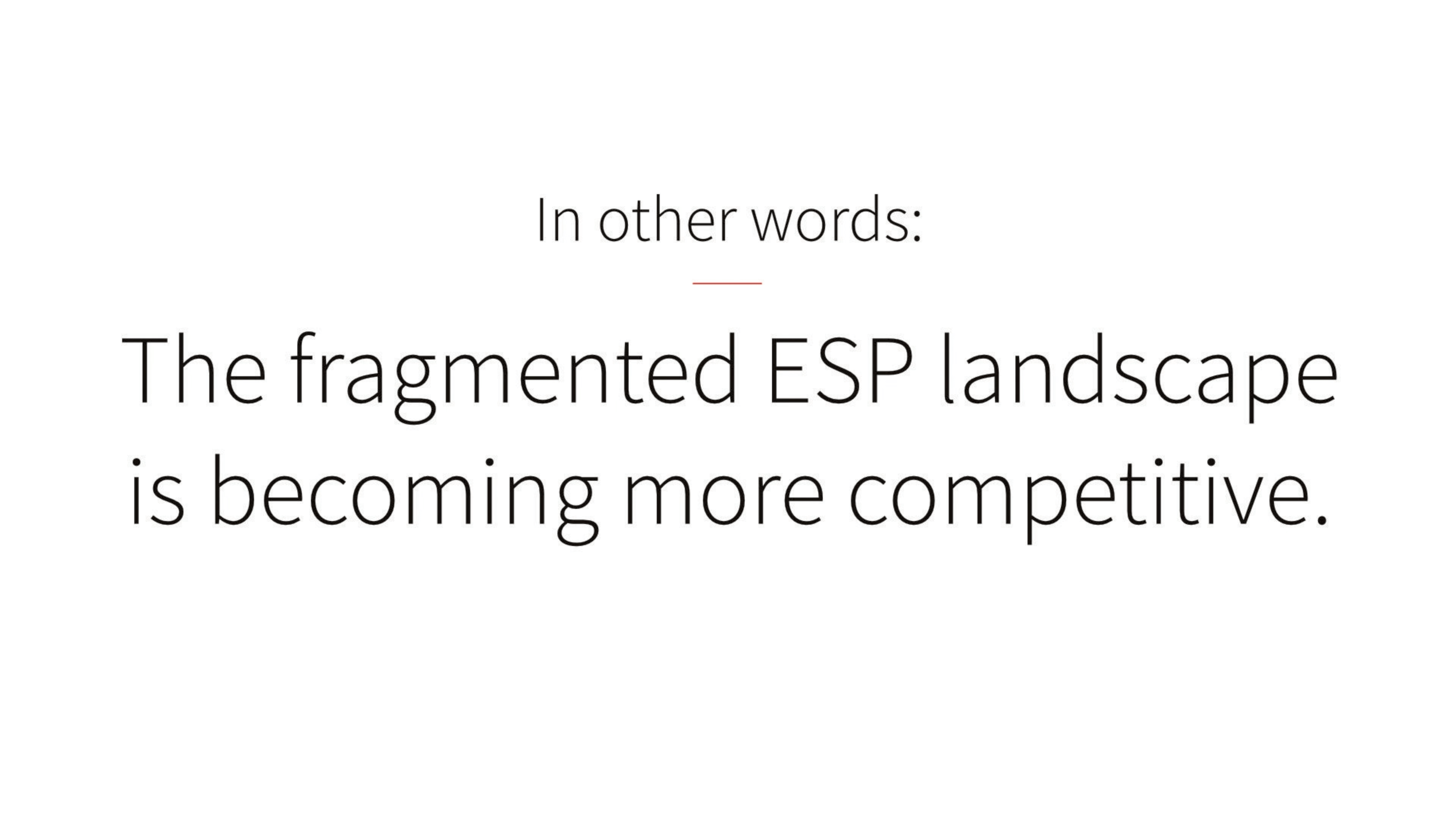
What this means is this already fragmented ESP landscape is going to become more competitive. A lot of competition in our space. So if you're not exactly thrilled, I think you have to always look at it in comparison to some other thing that you might have that you might also be less than thrilled about. It's a bit of a challenging space.
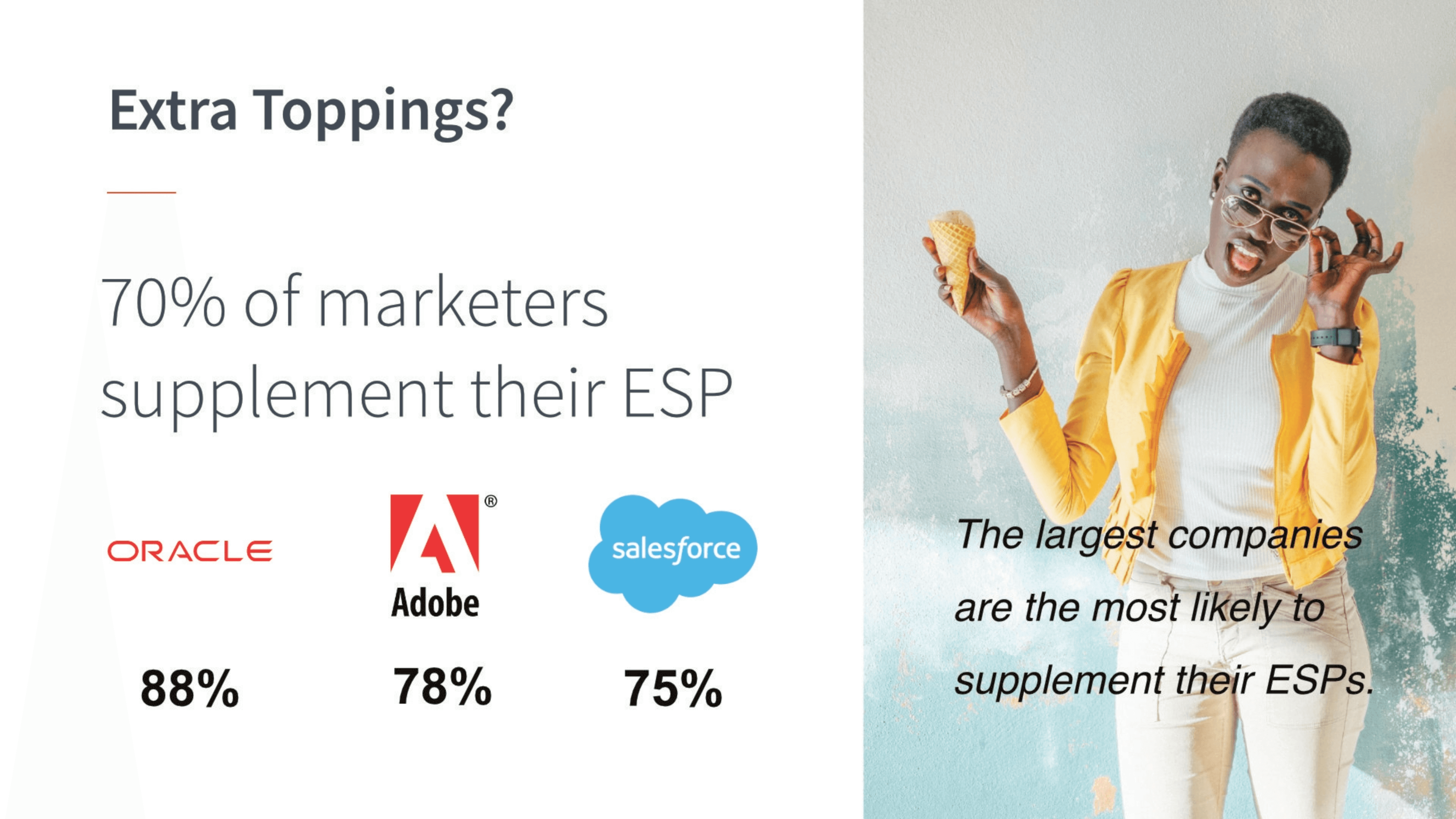
That leads us into extra toppings. This is the idea of supplementing your ESP. 70% of you are doing that. I think it should be 100%. All of you should be using either Litmus or Email on Acid. You should at least be doing that. That should get us to 100% right there. But of course, there's all kinds of other opportunities to use other types of services, whether it's analytics or something like Moveable Ink, or Kickdynamic, or Liveclicker. There are lots and lots of ways that you can supplement your ESP to make it work harder for you.
I reject this idea that your ESP is your be all end all. It should not be the one purchase you make and then you're all done. Part of supporting my view is that these three ESPs that the largest companies use, they are most likely to be supplementing their ESP with something else. The most sophisticated email marketing platforms are being supplemented at the highest rates that should tell you that this really should be the status quo. You should be supplementing your ESP with other things that are out there.
88% for Oracle. That's great. Again, I think it should be 100%. There's great stuff out there that isn't currently offered inside of any ESPs. So make sure you're using that.
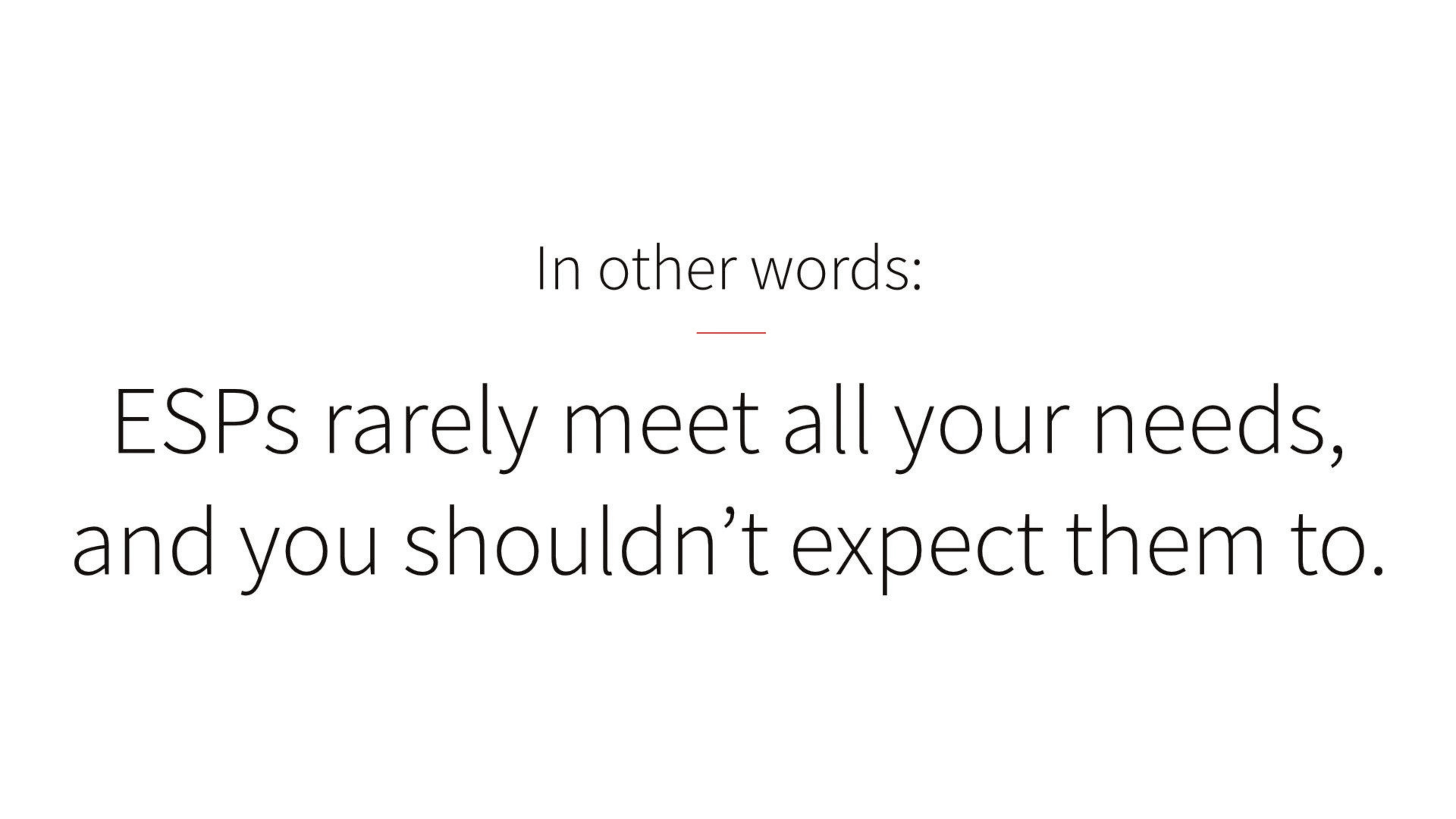
ESPs are rarely meeting all of our needs and you shouldn't expect them to. That's the punchline. I think that we have slightly unrealistic expectations of what our ESP should be doing for us. They should not be the one thing that we're using.
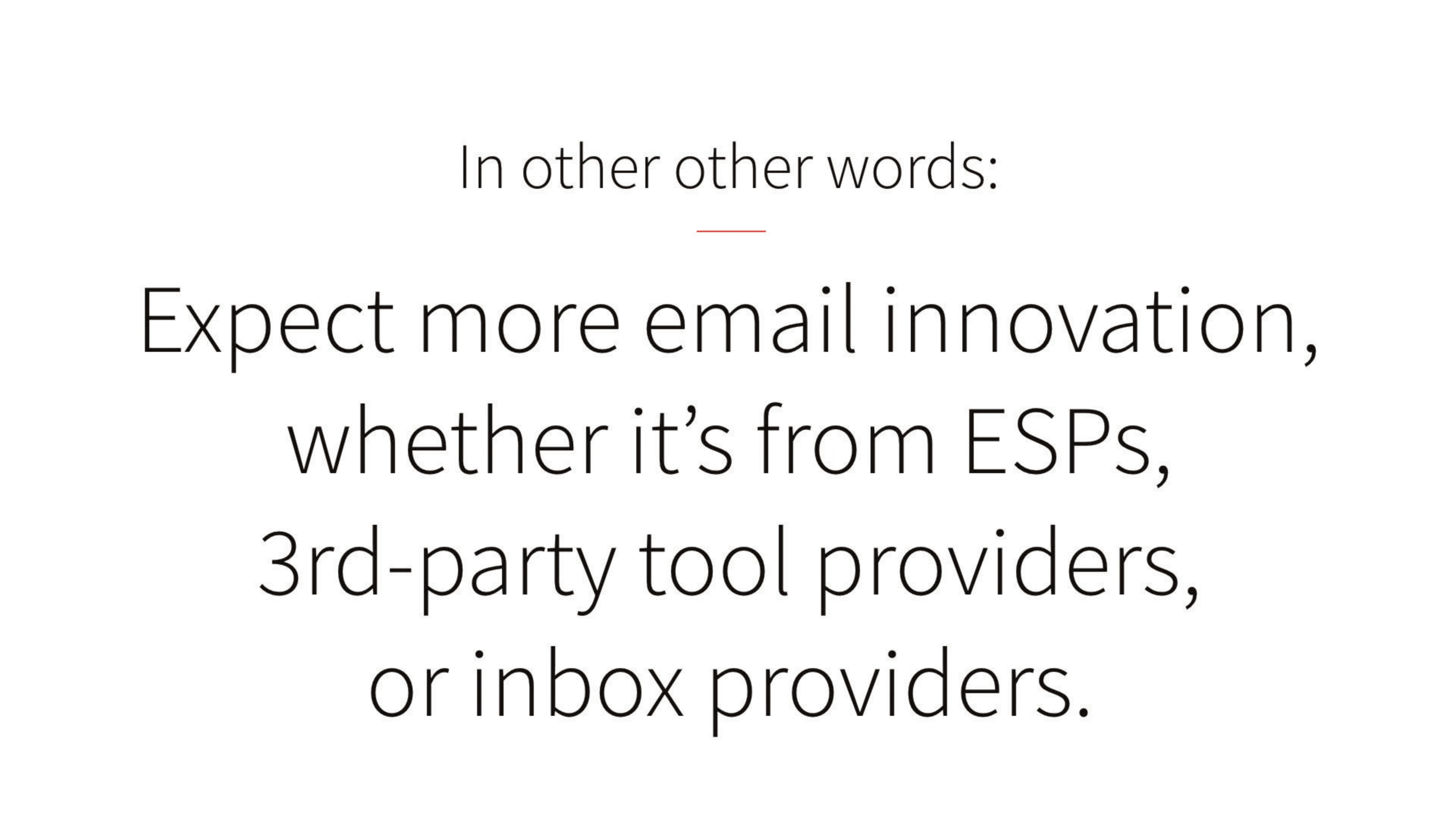
You should be expecting much more email innovation, whether it's coming from your ESP or some third party tool or inbox providers. This is an industry that is not standing still.

You should expect your jobs to continue to change, and it's time to better level up your skills at a conference soon and make sure you're on top of all these things.
And with that, I thank you.
